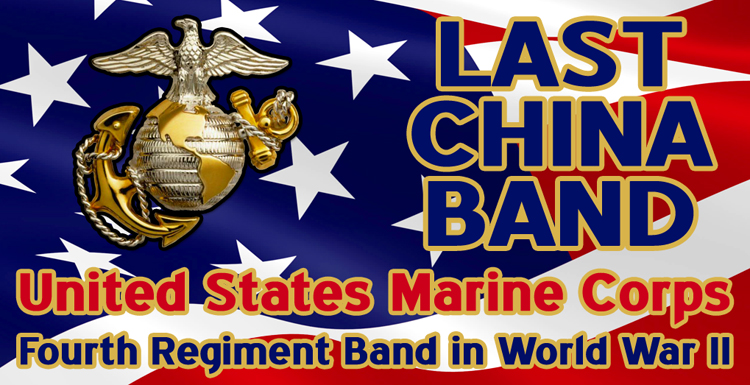United States Marine Corps
4th Regiment in World War II |
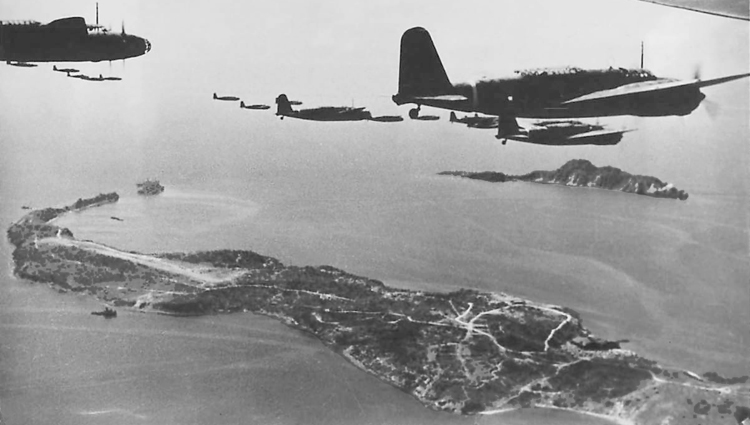 |
| United States Marines Fourth Regiment defend
the Philippine Islands at Corregidor Island, "the Rock", and Bataan
Peninsula against air raids, shelling and landings in the Empire of
Japan attack on the United States of America at Pearl Harbor, Hawaii
and Manila Bay, the Philippines on December 7, 1941, and United States
entry in to World War II. Imperial Japanese Ki-21 heavy bombers over
Corregidor Island photo above. |
|
|
|
|
YouTube
Video
Click Top for
Full Screen |
|
|
Color Film of a
Japanese Army Officer
and the Forbidden City
US
Marines in Beijing, China
1939 Pre-World
War II
"Last China Band"
Music: In The Mood, Glenn Miller
|
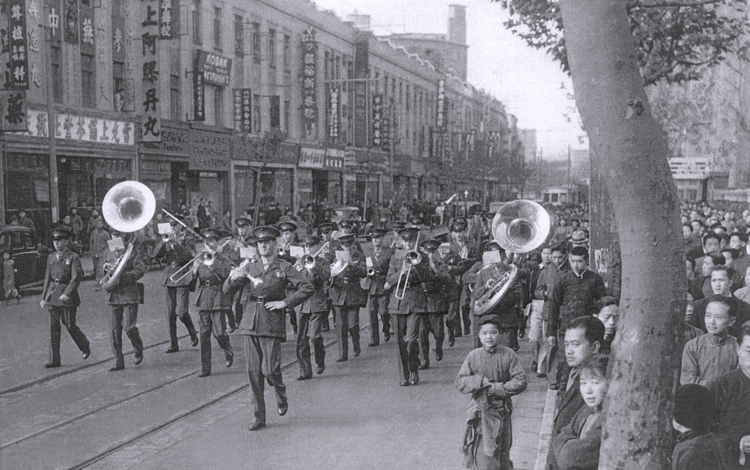 |
Shanghai,
China
November 28, 1941 |
| The United States Marine
Corps Fourth Regiment Band marching in Shanghai, China on November 28,
1941 only ten days before the December 7, 1941 attack by the Japanese
Empire against the United States at Pearl Harbor, Hawaii and Manila
Bay, Philippine Islands. |
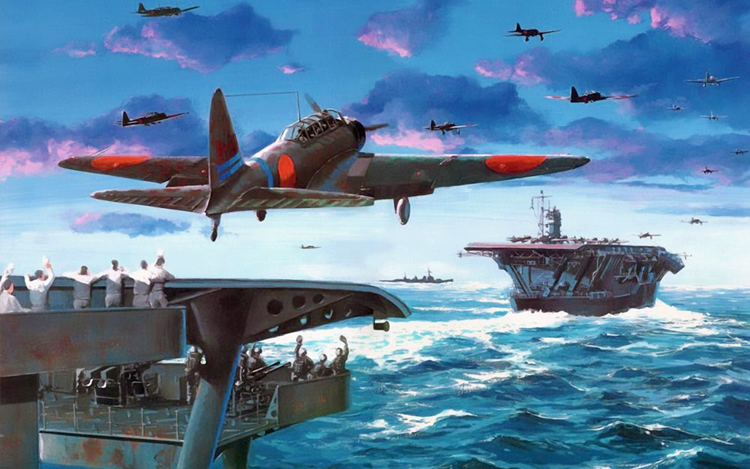 |
| December 7, 1941 Attack by Imperial Japan
Against the United States at Pearl Harbor, Hawaii Includes Six Aircraft
Carriers Which Launch 350 Fighters, Bombers and Torpedo Bombers |
|
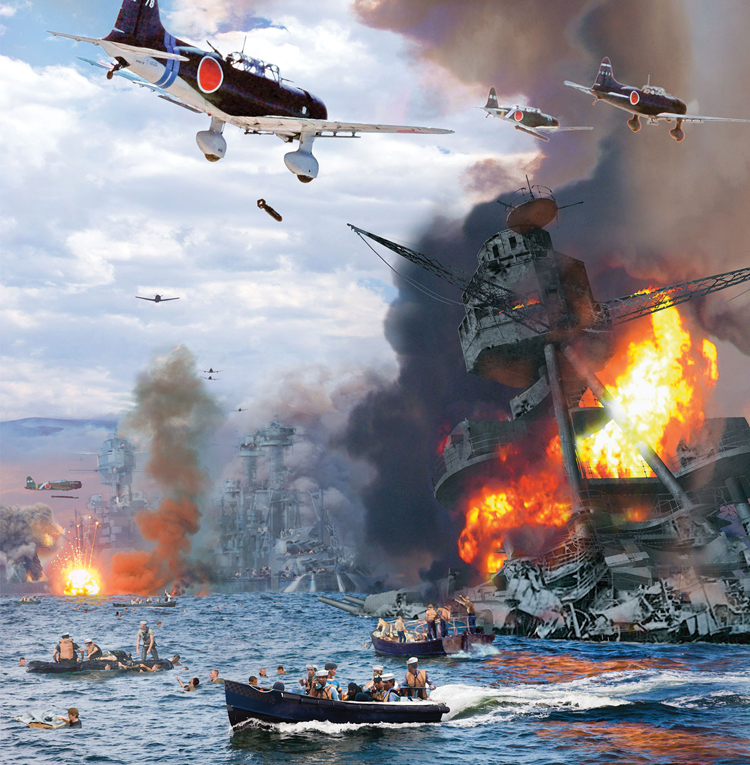 |
| Attack
by the Japanese Empire on Pearl Harbor Sinks or Badly Damages Eighteen
US Navy Ships, Damages or Destroys 300 US Aircraft and Kills 2,403 US
Military and Civilians |
|
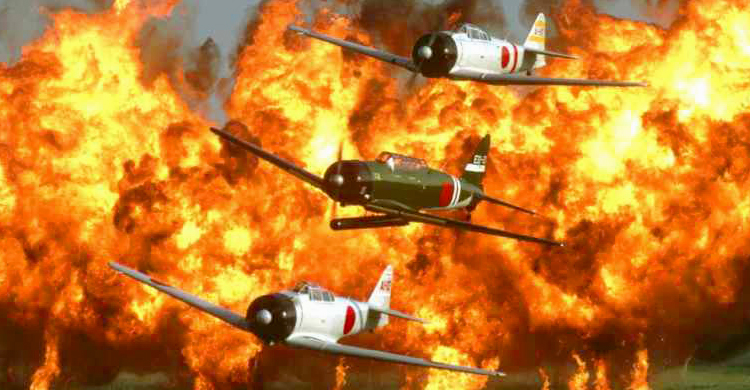 |
| December
7, 1941 Military Offensive by Japan Against Pearl
Harbor, Hawaii Continues Ten Hours Later Against Bombing Targets on
Manila Bay in the Philippine Islands |
|
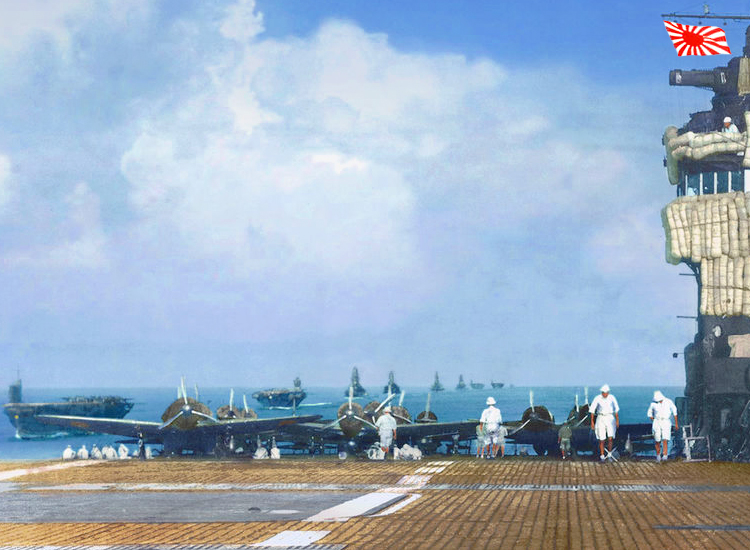 |
| March
26, 1942 Imperial Japanese Navy Aircraft Carrier Akagi at Staring Bay,
Dutch East Indies (Indonesia), Fleet Refueling Point for Warships of
the IJN, Sorties Out of Which Include Air Raids on Darwin, Australia
February 19, 1942 and March-April 1942 Attacks Against Allied Forces
and Shipping as Far West as Ceylon (Sri Lanka), South of India in
Japanese Offensive Against the Allies China, Burma (Myanmar) and India,
CBI Theater of Operations, Before Refitting in Japan and June 1942
Fateful Rematch with US Navy Fleet at Midway |
|
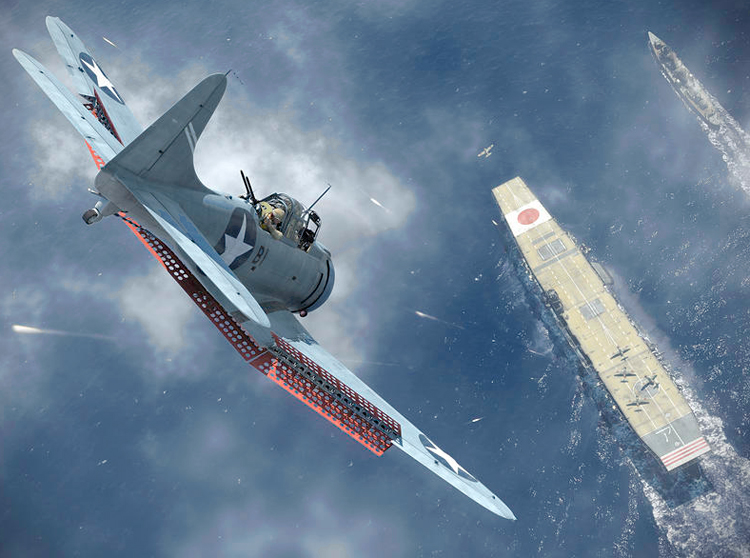 |
| June
4-7, 1942 US Douglas SBD Dauntless Dive Bombers Destroy
Imperial Japanese Navy
Aircraft Carrier Akagi, Above, and Three Other IJN Aircraft
Carriers, Kaga, Hiryu and Soryu, All Pearl Harbor Attack Participants,
at
the Battle of Midway Island |
|
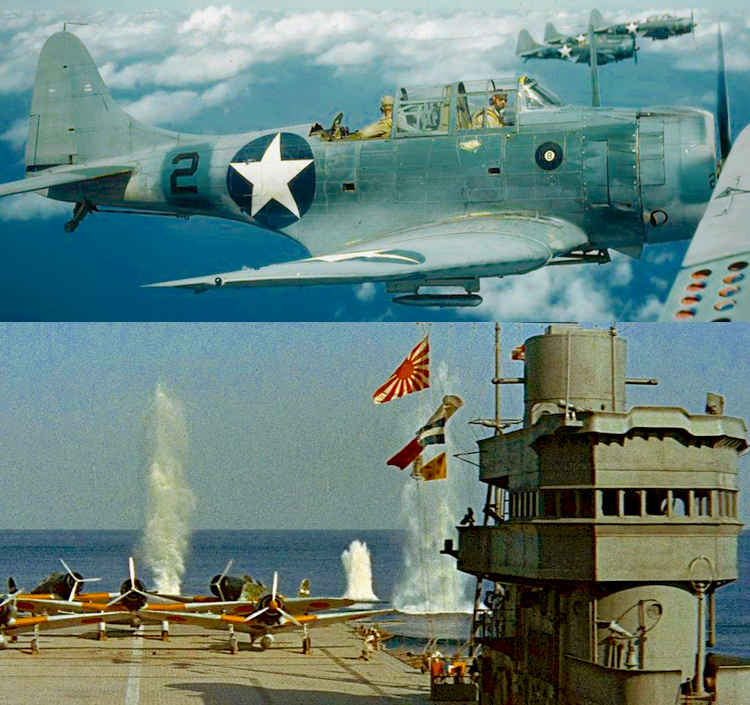 |
|
 |
| Shanghai,
China September 1941 |
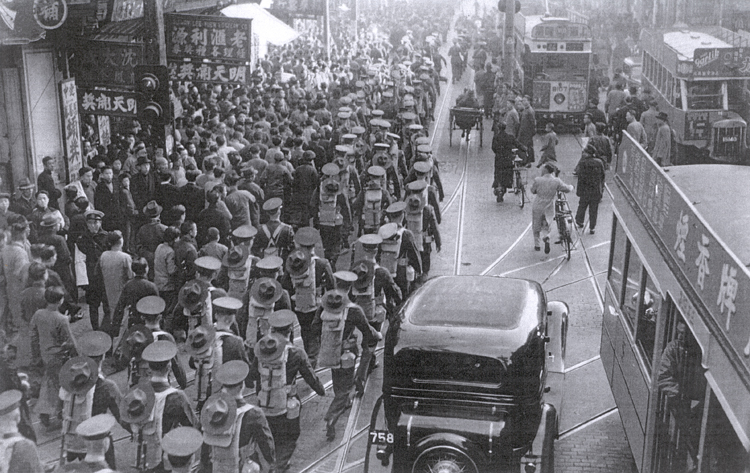 |
Shanghai,
China
November 28, 1941 |
| Troops of
the First Battalion,
Fourth Marines march down Nanking Road, on their way to the quays of
the Whangpoo River preparatory to embarking on U.S. President Line
ships for the Philippine Islands. The Marines share the crowded streets
with examples of every mode of transportation available. |
| |
| The
troops are carrying “Heavy
Marching Order” packs topped with neatly blocked campaign hats, armed
with Springfield 1903 rifles at the left shoulder. Beneath each hat is
the standard issue foul weather gear called a “pancho” and entrenching
tool. At the head of this column pictured, the Fourth Marines Band can
be seen breaking out into brighter sunlight. This proved to be a false
foreboding as this historic field band would cease to be one in only
ten more days. |
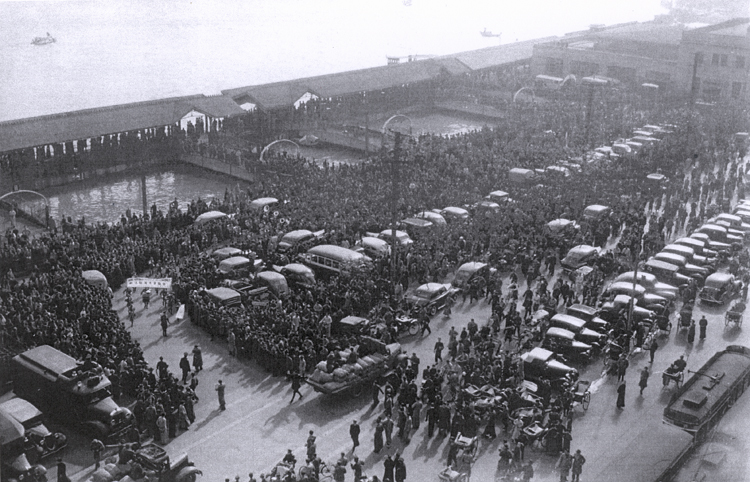 |
Shanghai,
China
November 28, 1941 |
| Birds eye view of quays on the banks
of the Whangpoo River, the port of Shanghai during the farewell of the
Fourth Marines as it prepares to leave the International Settlement. |
| |
| Throngs of people are seen
gathered among the limousines of the world’s diplomatic, consular force
and business firms watching troops of the First Battalion arrive led by
the Fourth Marines Band (note: Sousaphone base horns just to left of
picture center). Plainly seen in the line of march carrying a large
banner are elements of Shanghai’s Volunteer Defense Force wearing kilts
and playing bag pipes. Shortly after this resounding, amazing and
confusing send off, the 800 Marines of the Fourth Regiment depart for
the Philippines ending their duty in Shanghai after many years. |
|
Western Pacific
Ocean
and East Asia
|
|
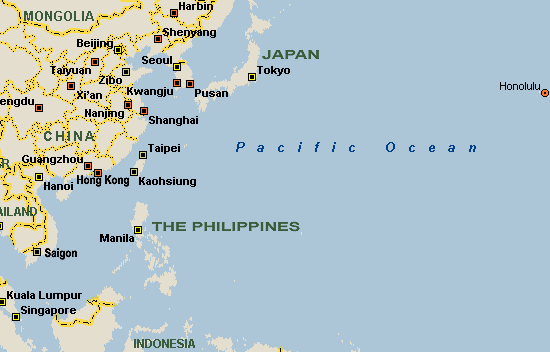 |
|
World War II in the Pacific
April 1941 Until July
1942 Flying Tigers, American Volunteer Group (AVG), US Pilots, Curtiss
P-40 Warhawk Fighters, Initially Resupplied Through Burma (Myanmar) and
French Indochina (Vietnam, Laos and Cambodia), Defend Yunnan Province,
Republic of China from Bombing and Invasion by Imperial Japanese Army
Moving West Through Major Cities Since 1937 Against Strong Chinese
Resistance and Causing High Civilian Casualties as in Nanking (Nanjing,
Jiangsu Province) |
|
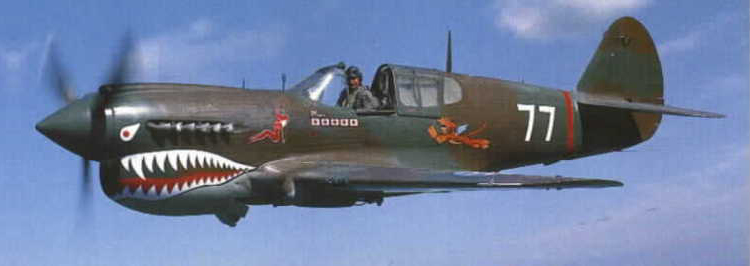 |
| South China Sea Region French Colonial Map |
|
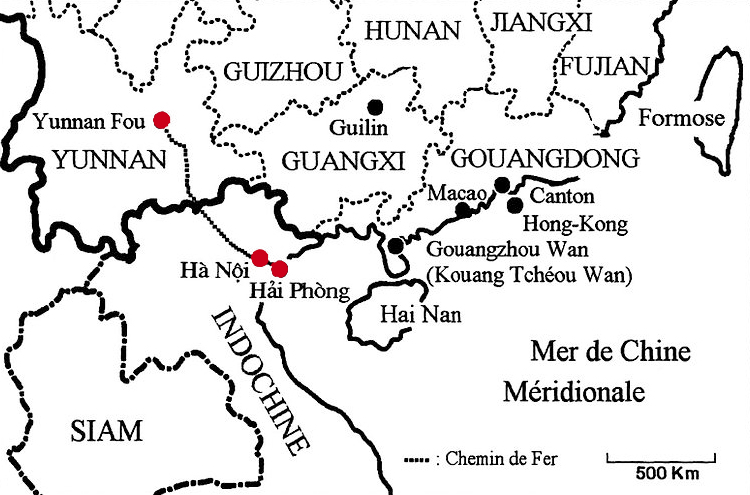 |
| French
Indochina (Vietnam, Laos and Cambodia) and Southwest Republic of China
Major Railroad Link from Haiphong Harbor (Hai Phong) Through Hanoi
(Ha Noi) to Kunming (Yunnan Fou), Largest City in Yunnan Province |
|
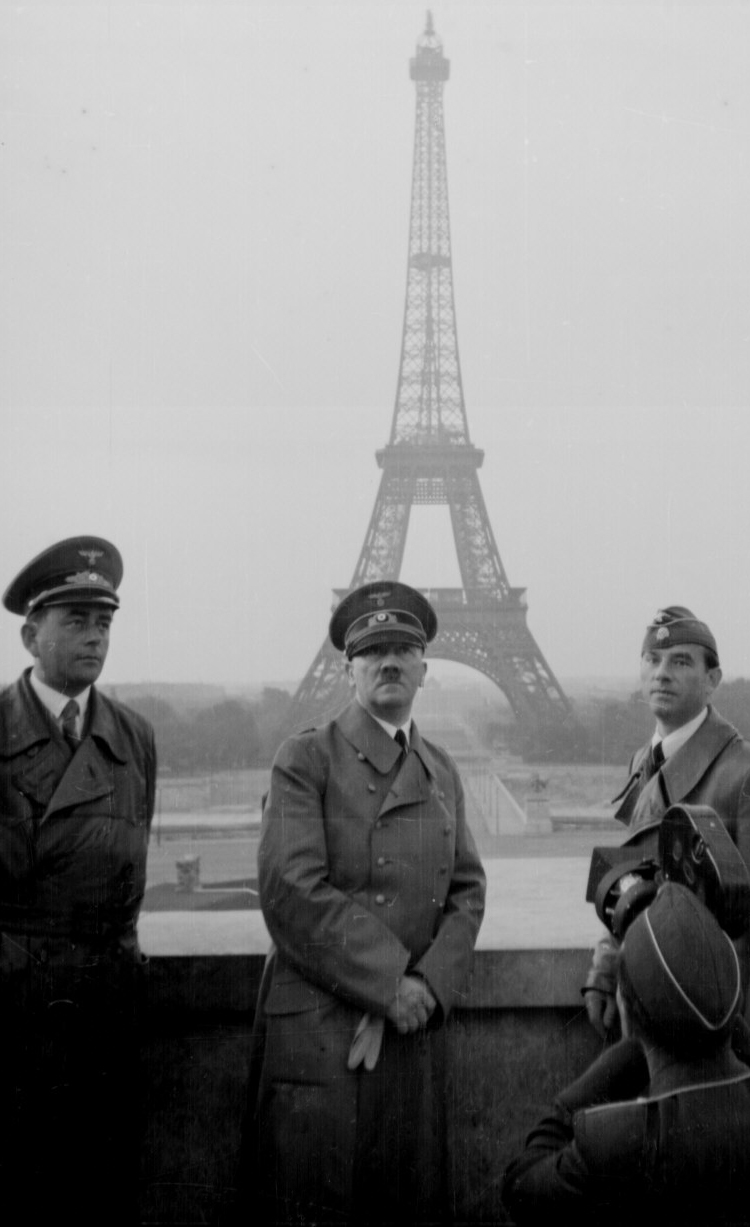 |
| June 23, 1940 Hitler in Nazi Germany Occupied
Paris, France |
|
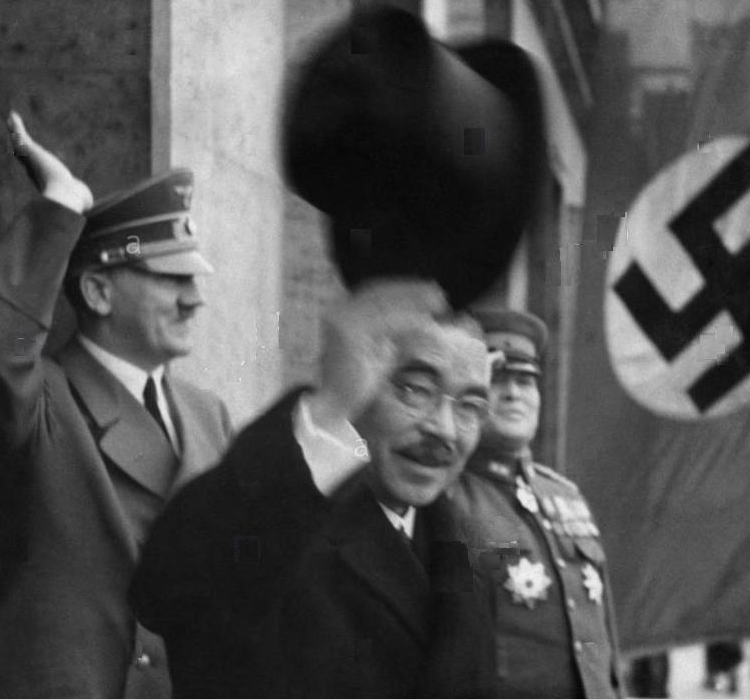 |
| September
27, 1940 Germany, Japan and Italy Sign Tripartite Pact Military
Alliance and Hitler Controlled Vichy France Government is Forced to
Allow Japanese Empire to Occupy French Colony of Indochina (Vietnam,
Laos and Cambodia), Starting with the Northern Tonkin Gulf Coast Region
and Major Port of Haiphong, If Any Doubt Remained Before, the Second
World War in the First Half of the Twentieth Century Truly Now Has
Commenced |
|
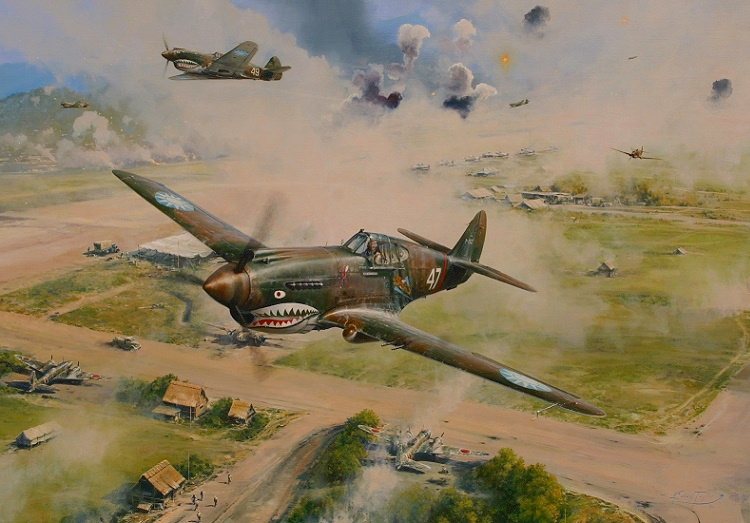 |
| September
26, 1940 Japan Blocks Haiphong Harbor and Rail Route Through Hanoi in
French Indochina (Vietnam, Laos and Cambodia) to Kunming, Yunnan
Province, Republic of China to Further Military Supplies for Chinese
Resistance Against Brutal 1937 Imperial Japanese Army Invasion and
Continued Incursion West, While US Government Concerned About Access to
South China Sea Resources Such as Rubber, Oil and Minerals, Demands
Japanese Military Withdraw from French Indochina, Seizes Japanese
Assets in US and Imposes Sanctions Against US Exports to Japan such as
Refined Petroleum Products and Scrap Metal, Pictured Above, Flying
Tigers, American Volunteer Group (AVG) US Pilots, Curtiss P-40 Tomahawk
Fighters with Republic of China Wing Markings Strafing Attack on
Imperial Japanese Army Heavy Bombers at Forward Airbase |
|
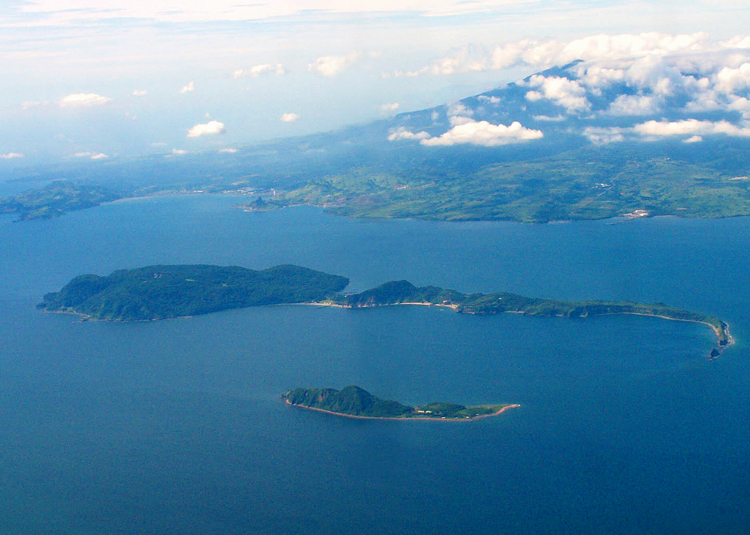 |
| November
28, 1941 United States Marine Corps Fourth Regiment Ship Out from
Shanghai, China for Corregidor Island and Bataan Peninsula, Top of
Photo Above, in Manila Bay on Main Island of Luzon, the Philippines,
Still Seemingly at Peace Only Ten Days Before the Empire of Japan
Initiates Near Simultaneous Major Military Attacks there and at Pearl
Harbor, Oahu Island, Hawaii |
|
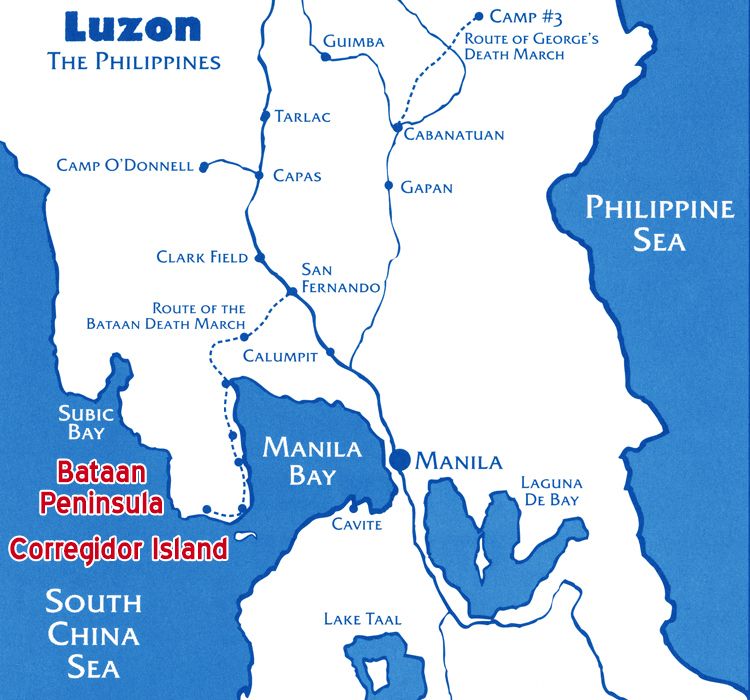 |
|
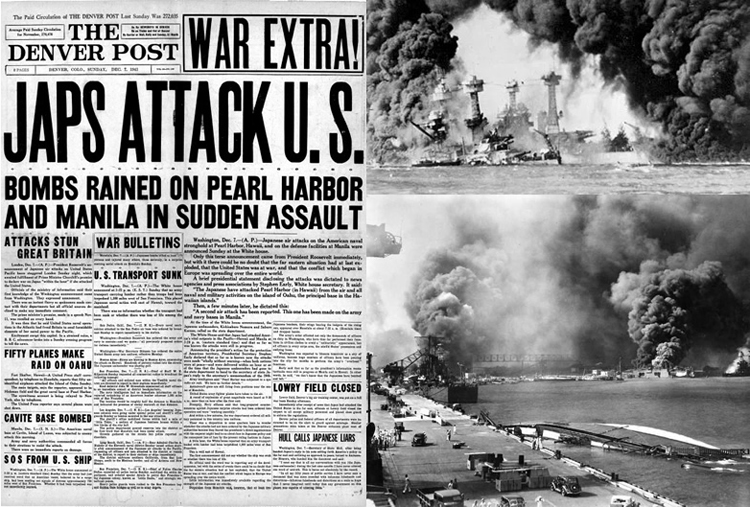
|
| December 7, 1941 Imperial Japanese Government
Preempts Expected US Oil Embargo Enforcement by Attempting to Eliminate
US Navy Pacific Fleet in Hawaii and the Philippines as well as
Attacking British Military at Hong Kong and Singapore |
|
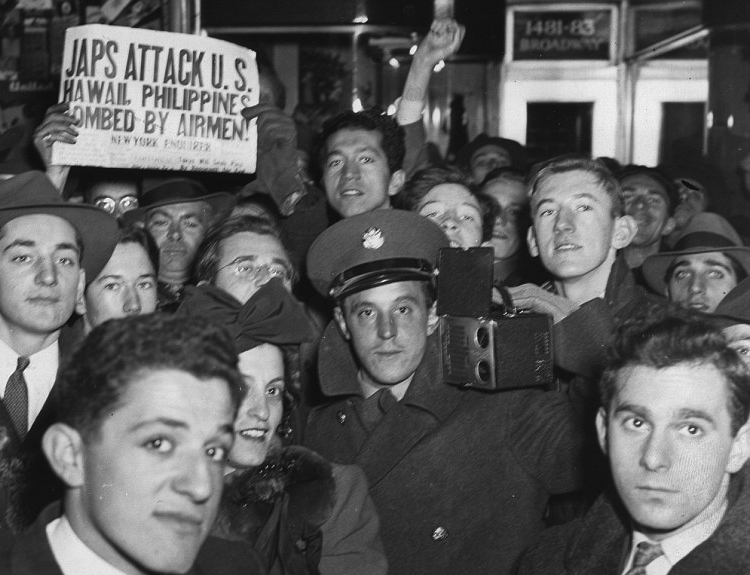 |
|
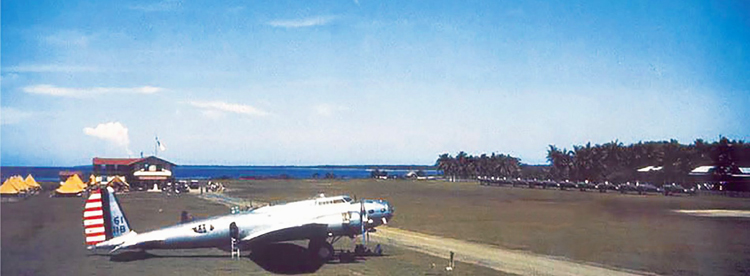 |
| October
1941 US Boeing B-17 Bomber and Fighter Aircraft at Iba Airfield, Luzon
Island Which is Attacked Among Other Philippine Islands Targets Just
Ten Hours After the December 7, 1941 Imperial Japanese Attack at Pearl
Harbor, Hawaii |
|
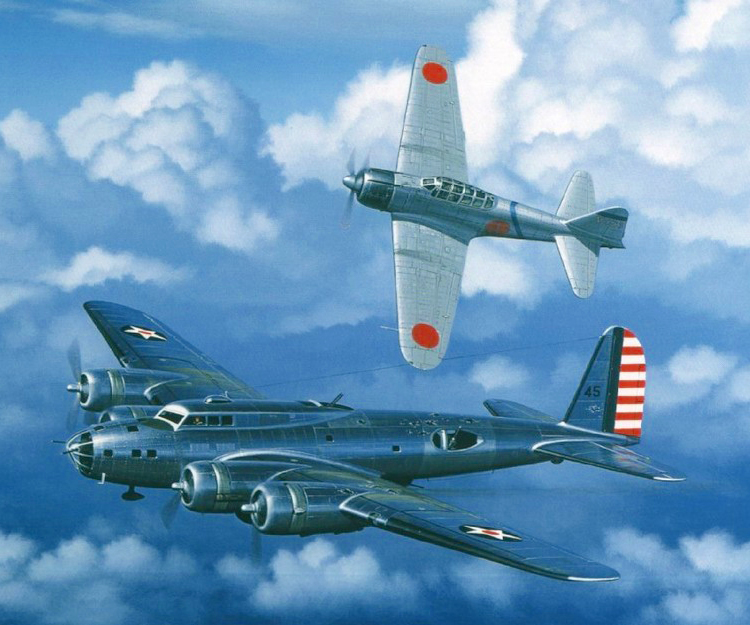
|
| US Boeing B-17 Bomber and Japanese A6M
Zero Fighter |
|
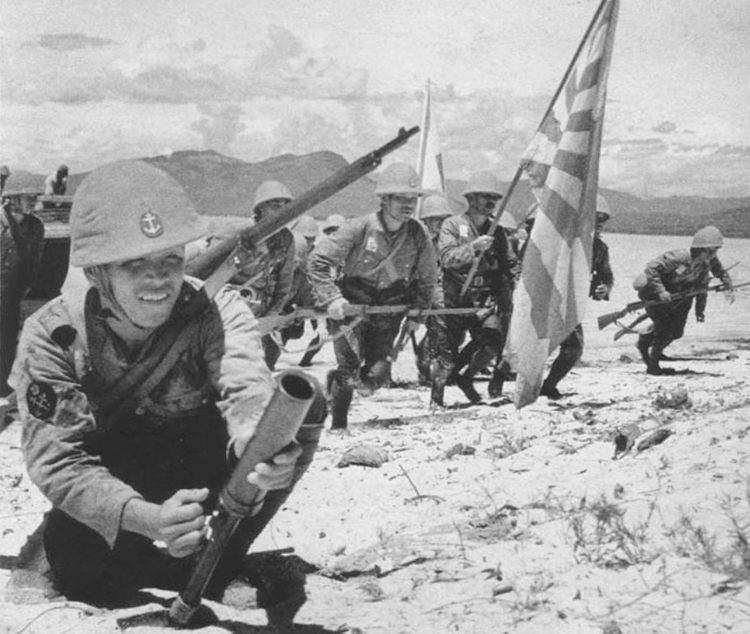 |
| December
7, 1941, Across International Date Line December 8, Still on Same Day
as Attack Against Pearl Harbor, Hawaii, Imperial Japanese Marines
(Rikusentai) Special Naval Landing Forces (SNLF) Initiate First
Infantry Assault on Philippine Islands at Batan Island North of Luzon
Island, Photo Above a Year Later, December 1942, Stage Landing for
Cameras in Dutch East Indies (Indonesia), Identified by Anchor Insignia
and Rising Sun Naval Ensign Used as Flag and on Armored Vehicles and
Other Shore Equipment While Imperial Japanese Army (IJA) Use White Flag
with Red Circle for Similar Purposes |
|
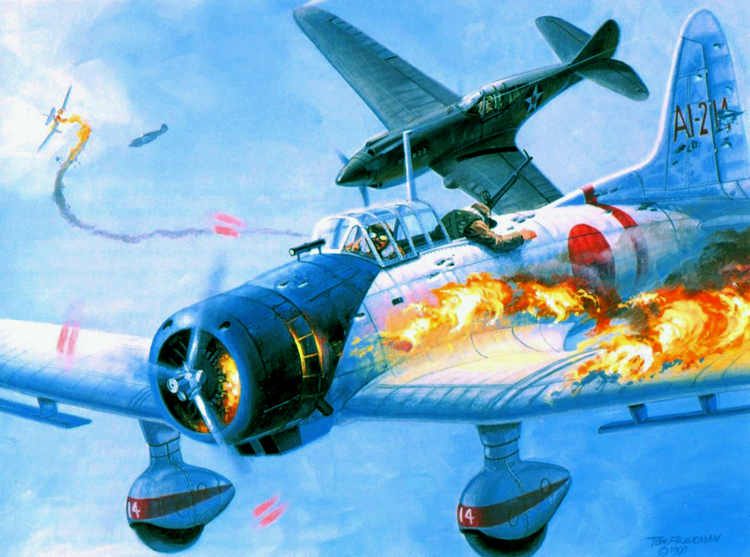 |
| US Curtiss P-40 Warhawk Fighter Strikes Back at
Imperial Japanese Navy D3A Val Dive Bomber |
|
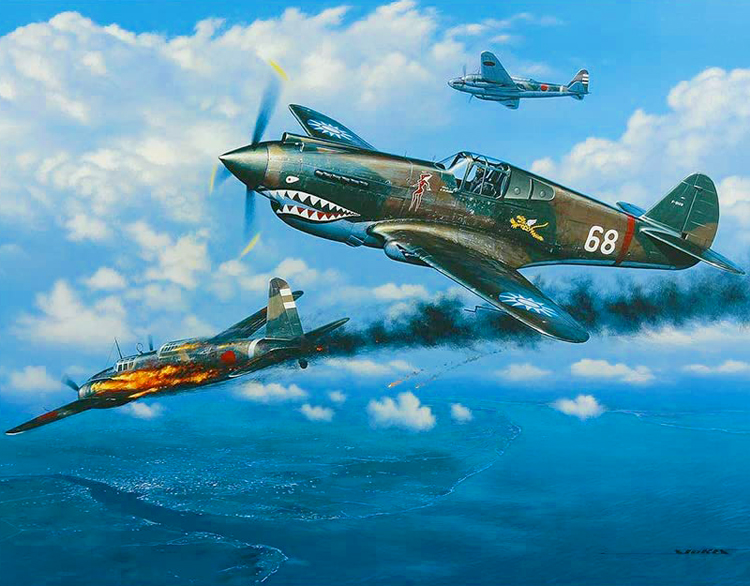 |
| December
23, 1941 Flying Tigers, American Volunteer Group (AVG) US Pilots,
Curtiss P-40 Warhawk Fighters with Republic of China Wing Markings Over
Rangoon, Burma (Yangon, Myanmar) Repel Sixty Japanese Ki-21 Sally Heavy
Bombers |
|
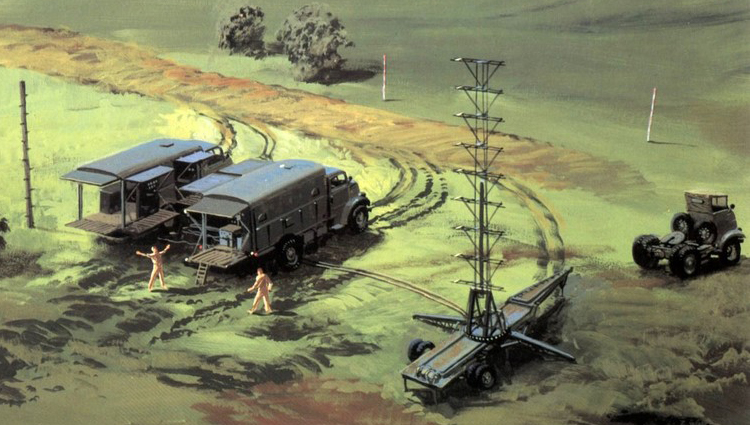 |
| Radar,
the Word Still Classified, First Combat Uses by US Army and Marines
Mobile Air Warning Services During Initial Imperial Japanese Attacks at
Pearl Harbor and Manila Bay |
|
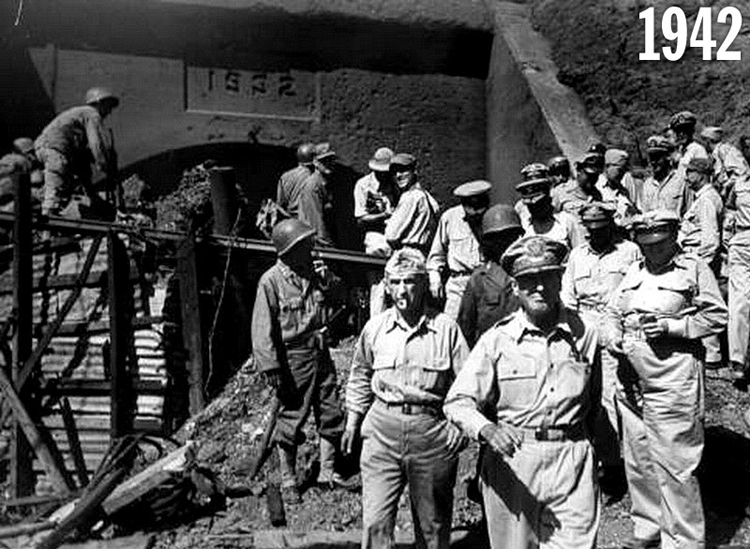 |
| March
11, 1942 US Army General Douglas MacArthur, Vowing to Return, Leaves
Malinta Tunnel on Corregidor Island in Manila Bay, the Philippine
Islands for Australia by PT Boat and B-17 Bomber While Imperial
Japanese Army Continues Siege of Shelling, Air Raids and Landings
Against Surrounded US Marines, Army, Navy and Philippine Personnel on
Corregidor Island During Five Months of Allied Armed Resistance |
|
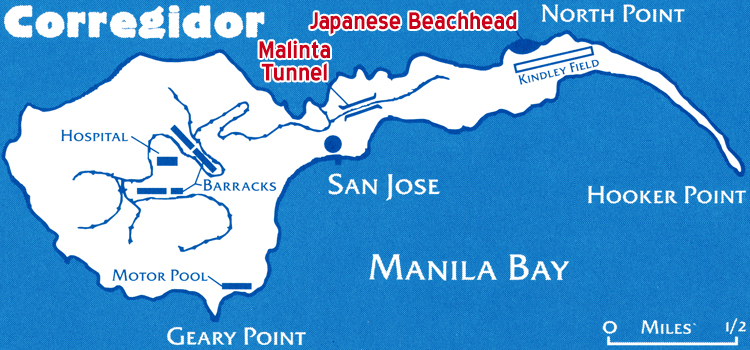 |
|
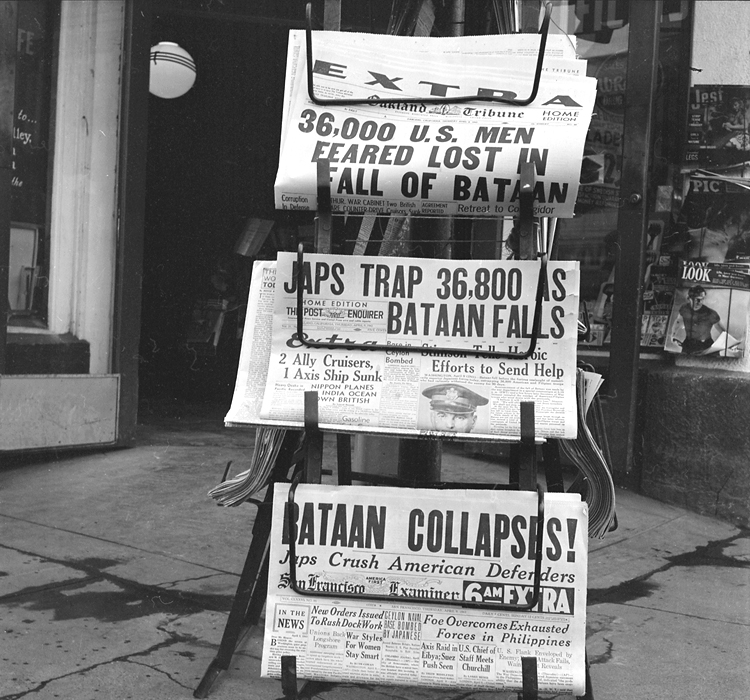 |
| April
9, 1942 Surrender of Allied Forces on Bataan Peninsula of Luzon, Main
Island of the Philippines, Directly North of Corregidor Island,
Imperial Japanese Army Adds Shore Artillery Attacks Across Narrow
Channel in Manila Bay, and One Month Later is Finally Able to Land
Tanks on Corregidor May 6, 1942 |
|
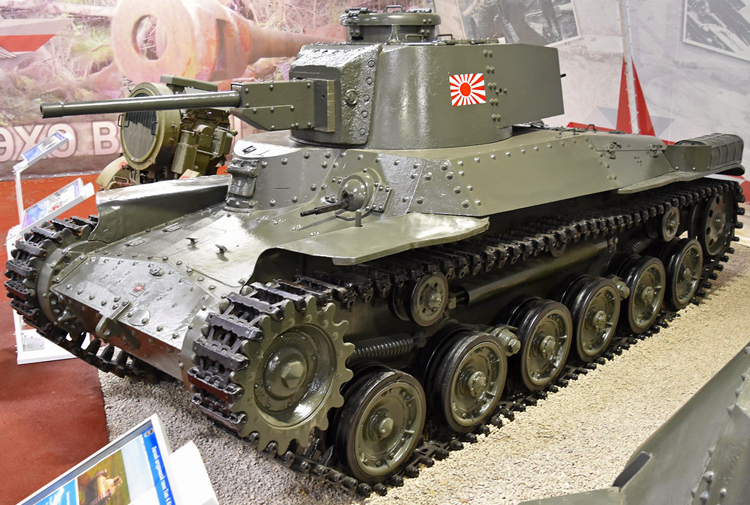 |
| May
6, 1942 Two Type 97-Kai ShinHoTo Chi-Ha Medium Tanks and One M-3 Stuart
Tank Captured on Luzon Island Are Landed by Imperial Japanese Army
Assault Forces on Corregidor Island |
|
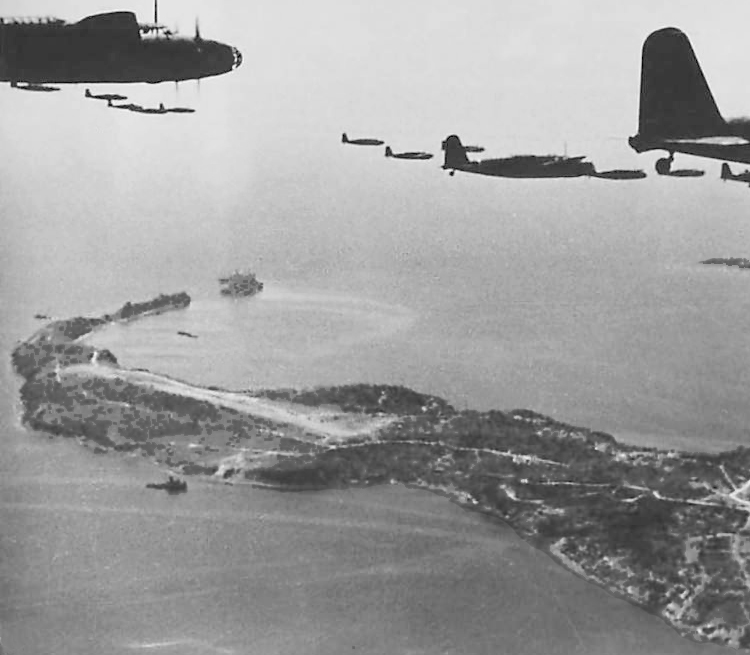 |
| May
6, 1942 the 4,000 US and Allied Forces, Including 1,500 US Marines, Are
Ordered to Surrender After Defending Corregidor Island for Five Months
Since December 7, 1941, with Sustained Imperial Japanese Army Shelling
and Bombing, IJA Ki-21 Heavy Bombers Over Corregidor Photo Above, and
Increasing Casualties on Both Sides in Close Combat, IJA High Command
is Embarrassed by Unexpected Delay in the Announced Immediate Collapse
of US Armed Resistance on Corregidor Against Overwhelming Odds While
Running Out of Ammo and Repulsing Waves of Enemy Landings, Japanese
Military Divert Such Significant Resources to the Philippines that
Other Postponed Offensives as Against Australia Never Materialize |
|
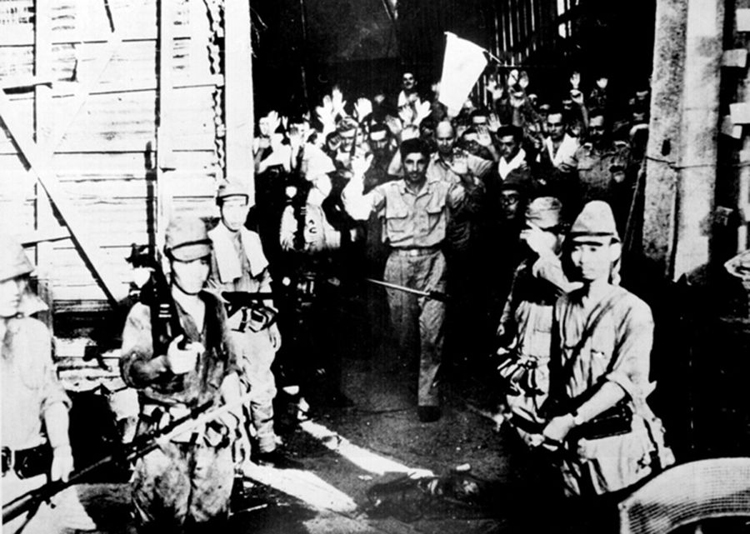 |
|
| Honor Versus Dishonor: The Pacific’s 4th Marine
Regiment |
| |
By MATTHEW M.
BURKE | STARS AND STRIPES
Published: April 5, 2018
CAMP FOSTER, Okinawa — Army Lt. Gen. Jonathan Wainwright ordered the
surrender of U.S. forces in the Philippines on May 6, 1942, following
an overwhelming six-month Japanese onslaught.
Marine Col. Sam Howard — commander of the 4th Marine Regiment — ordered
the national and regimental colors burned rather than see them fall
into enemy hands. The Marines reluctantly went into a brutal captivity
at the hands of the Japanese.
The 4th Marine Regiment hasn’t been stationed in the continental United
States since then. It is the only regiment whose lineage is rooted on
the American mainland to deploy to the Pacific and never be rotated
back, Marine officials said.
Rumors have swirled among Marines that the regiment is doomed to wander
the Pacific — much like the mythical ghost ship The Flying Dutchman —
due to the dishonor over surrendering. It is the largest organized
Marine unit to ever do so in battle.
Before elements of the regiment traveled to South Korea recently for
exercises Foal Eagle and Key Resolve, current 4th Marine Regiment
commander Col. Kevin Norton pushed back against that myth, saying it is
because of honor, not dishonor, that his Marines are stewards of the
Pacific.
“Like most things, there’s rumor and misconception,” said Norton, who
has spent more than 10 years with the regiment in various leadership
positions. “We were still reeling from Pearl Harbor and we had to pick
and choose where we were going to send forces to, so in many ways, the
Marines and the U.S. Army and the Filipinos kind of got left hung out
to dry a little bit out of necessity, because the U.S. Navy and U.S.
Army had to kind of get their act together and mobilize in order to get
over here.”
The 4th Marine Regiment was activated at Puget Sound, Wash., on April
16, 1914, with Col. Joseph Pendleton — namesake for Camp Pendleton,
Calif. — as its inaugural commanding officer. The unit’s first duty
station was San Diego.
In June 1916, 4th Marines was dispatched to the Dominican Republic to
intervene on behalf of the government in their civil war, the Marine
Corps said. This would be the first time the unit would see combat, and
it was awarded two Medals of Honor for heroism.
The unit was then dispatched to Shanghai, China, in March 1927 to
protect American interests in the face of yet another civil war. Known
as the “China Marines,” they stayed in country for nearly 15 years.
The China Marines departed for the Philippines on Nov. 27 and 28, 1941,
after being surrounded by the invading Japanese. They had been in the
Philippines for nine days when the Japanese attacked to coincide with
the attack on Pearl Harbor. |
|
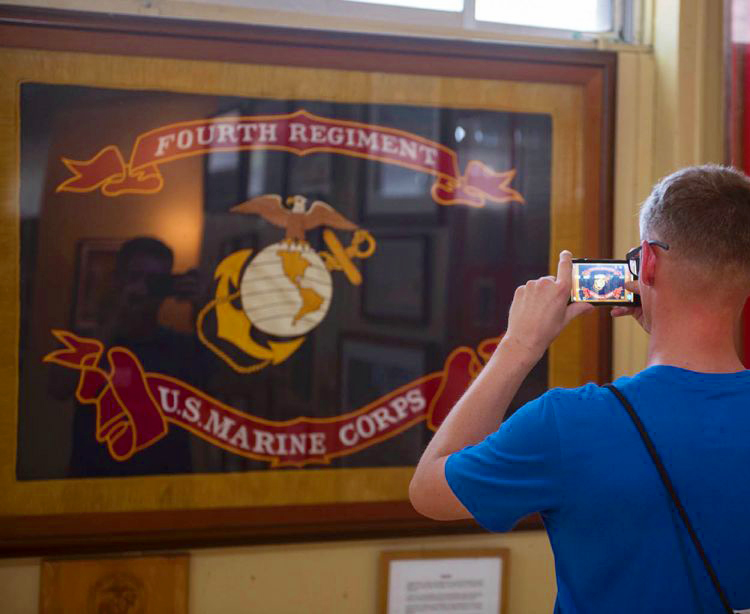 |
| May
5, 2017 US Marine with Okinawa Based 4th Marine Regiment Takes Photo of
Unit Colors at the Pacific War Memorial Museum at Corregidor Island,
Philippines |
|
| Surrender |
|
The 4th Marine
Regiment engaged the Japanese for the first time on Dec. 12, 1941, the
Marine Corps said. After arriving at Subic Bay, it had been tasked with
guarding Olongapo Naval Station and a naval base at Mariveles.
As the Japanese bore down on Manila from the north and defeat seemed
all but assured, 4th Marines in Olongapo evacuated to Mariveles and
then to Corregidor, the fortified island off the southern coast of the
Bataan Peninsula. They prepared and strengthened defensive positions as
the Japanese closed in.
The Japanese made landfall on Corregidor Island on May 5, 1942, the
Marine Corps said. The regiment inflicted heavy casualties on the
Japanese invaders, decimating the first two attempted landings;
however, they were no match for Japanese planes, tanks and Bataan-based
artillery. The Japanese gained a foothold on the beach and expanded it,
pushing toward Wainwright’s headquarters.
The Marines lost all of their heavy guns and were almost out of
ammunition. All seemed lost.
“Feeling that further resistance was useless and fearing a possible
massacre of 1,000 sick and wounded personnel in Malinta Tunnel, Gen.
Wainwright decided to surrender,” a unit history said.
Isolated pockets of Marines continued to fight four hours after the
surrender went into effect, until news of the order trickled down.
“The Marines were beside themselves,” Norton said. “They fought
valiantly for several days and then ultimately Gen. Wainwright ordered
the surrender because the higher headquarters folks were inside of a
tunnel and they didn’t have all the information and the communications
had been severed.”
Norton said Wainwright did what he thought was right, and the Marines
had to follow orders. The 4th Marine Regiment ceased to exist.
“I don’t think the United States nor Gen. Wainwright understood how the
Japanese were going to view prisoners,” Norton said. “There were some
big-time atrocities. There were executions regularly. It was a brutal
captivity. Most of those Marines who we refer to as the ‘old 4th Marine
Regiment’ spent all of World War II in prisoner of war camps or they
simply died in POW camps; it was that horrific.” |
|
|
| Proud
Lineage |
| |
While Howard’s
Marines tried to stay alive in brutal prison conditions,
the 4th Marines was resurrected Feb. 1, 1944, with members of the 1st
Marine Raider Regiment, a commando-style unit that had fought with
distinction in the Makin Island, Guadalcanal, Central Solomons and
Bougainville campaigns.
“If you talk to World War II vets, there was such a proud lineage of
the 4th Marines that it was a big deal for them to rename that Raider
regiment the 4th Marines,” Norton said.
The “new” 4th Marines participated in the recapturing of Guam and the
seizure of Okinawa at the cost of 4,000 of their lives, the Marine
Corps said. World War II ended with Japan’s surrender Aug. 15, 1945,
following the atomic bombings of Hiroshima and Nagasaki.
The 4th Marines — who were awarded five Medals of Honor for service
during the war — were chosen as the first American combat unit to land
in Japan for the occupation. They were there to welcome the “old” 4th
Marines, emaciated and in poor health, as they were liberated from POW
camps.
“They held a parade for many of the prisoners,” Norton said. “It was a
good homecoming for those guys because they realized the regiment was
still alive.”
The 4th Marines was deactivated in 1949 only to be reactivated three
years later for the Korean War. However, they arrived in Japan after
the armistice that ended the conflict was signed. They were sent to
Hawaii, the closest they would ever get to the continental United
States.
Through the years, the regiment has served with distinction in combat
in Vietnam and through advisers sent to Iraq and Afghanistan, leading
to nearly another dozen Medals of Honor. They were the last Marine
regiment to depart Vietnam in 1969 and have been on Okinawa ever since.
Today, 4th Marines is the anchor for the unit deployment program,
accepting stateside battalions into their ranks on six-month rotations
to the Pacific.
“Unlike units stationed in the United States permanently, we’re kind of
on the tippy, tippy part of the spear and our readiness is at the
highest levels permanently,” Norton said.
“When the Marines really learn the history, all that rumor and
conjecture of, ‘Hey, the surrender was dishonorable,’ you just have a
totally different perception … the Marines had nothing to do with the
surrender. There was no dishonor in it.” |
|
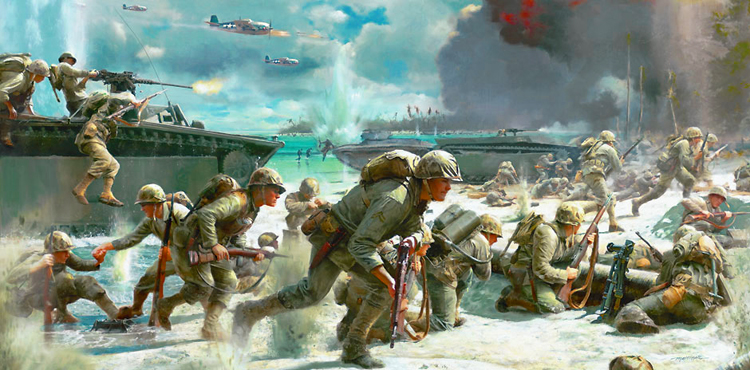 |
| September 15, 1944 US Marine Corps LVT (Landing
Vehicle Tracked) Assault on Fortified Imperial Japanese Army Garrison
at Peleliu Island in Allied Pacific Ocean Island Hopping Campaign from
Guadalcanal August 1942 to Okinawa April 1945 |
|
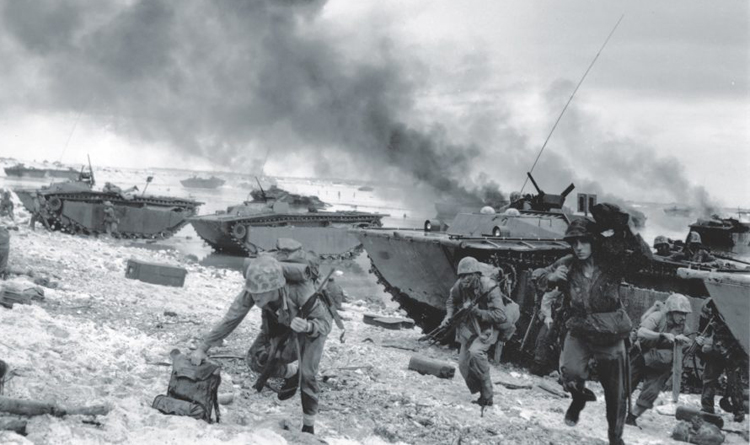 |
|
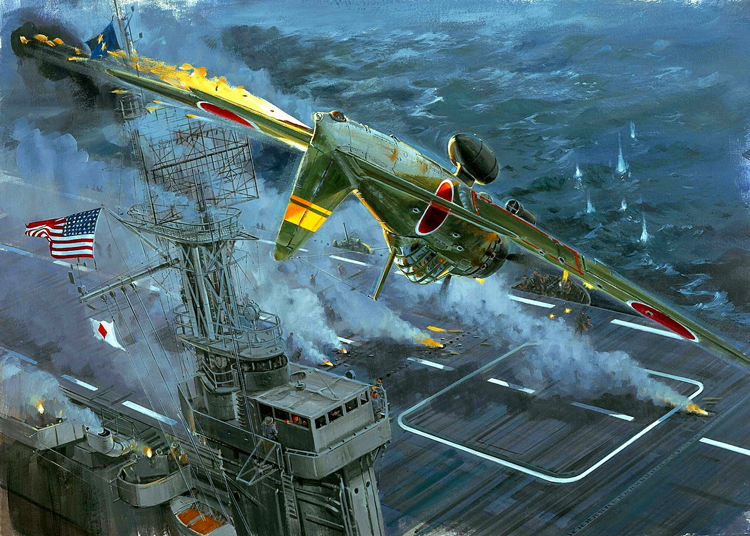 |
| October 25, 1944 Escort Aircraft Carrier USS
Kitkun Bay CVE-71 Damaged by Japanese Kamikaze A6M Zero Fighter in
Largest Naval Battle in World History at Leyte Gulf, Philippine Islands |
|
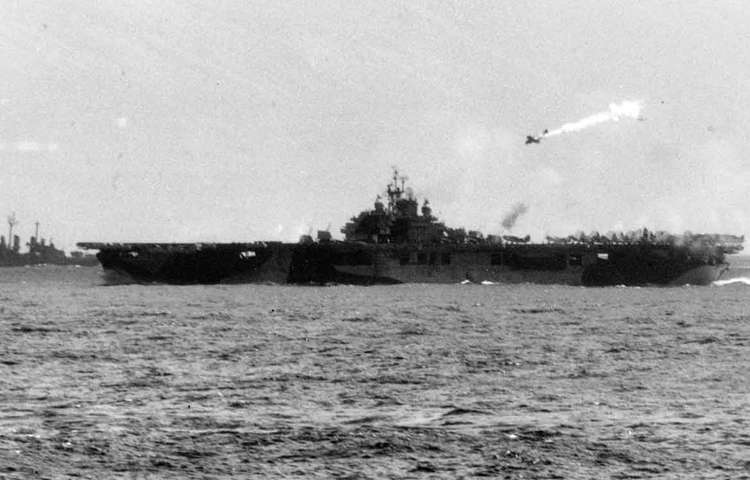 |
| November 25, 1944 Aircraft Carrier USS Essex
CV-9 Hit by Imperial Japanese Kamikaze Aircraft off Coast of Philippines |
|
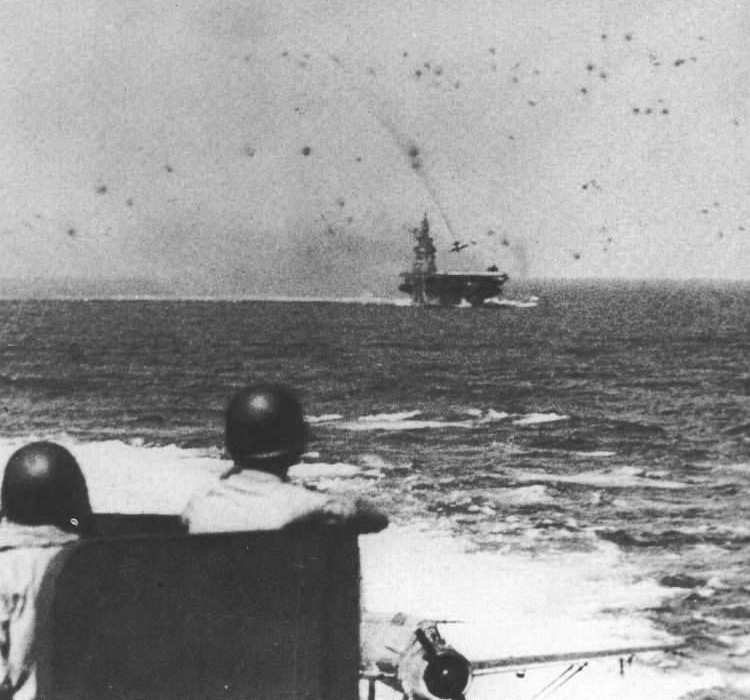 |
| November
25, 1944 Aircraft Carrier USS Intrepid CV-11 Hit by Kamikaze, One of
Three Japanese Aircraft Strikes on Intrepid During the Philippine
Islands Liberation Operation |
|
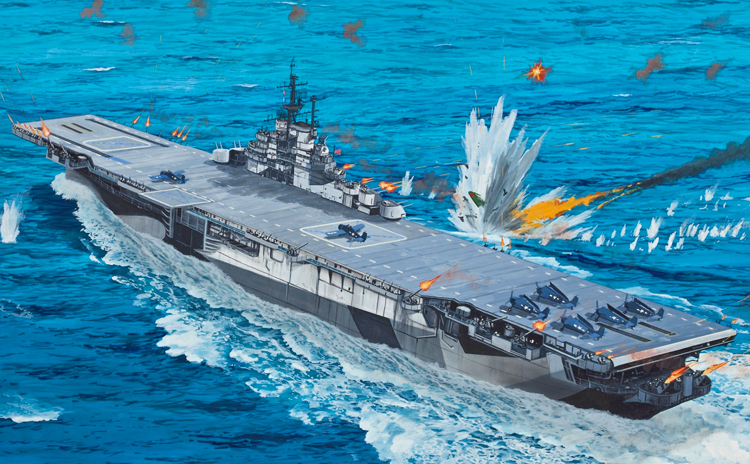 |
|
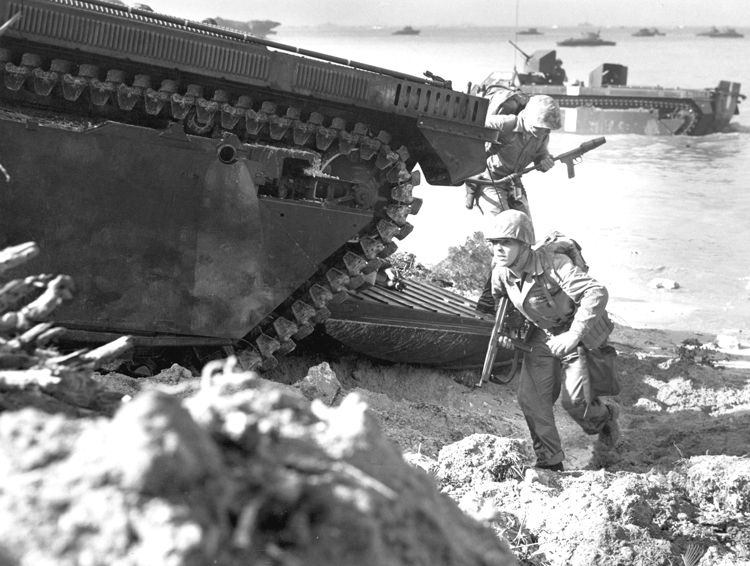 |
| April 1, 1945 USMC 2nd Battalion, 22nd
Regiment, LVT (Landing Vehicle Tracked) at Green Beach on Okinawa
Island, Last Major Battle of WWII, an Amphibious Invasion by Many
Metrics Larger than D-Day at Normandy, France and 98 Day Long Final
Reckoning for Conventional Imperial Japanese Military Forces |
|
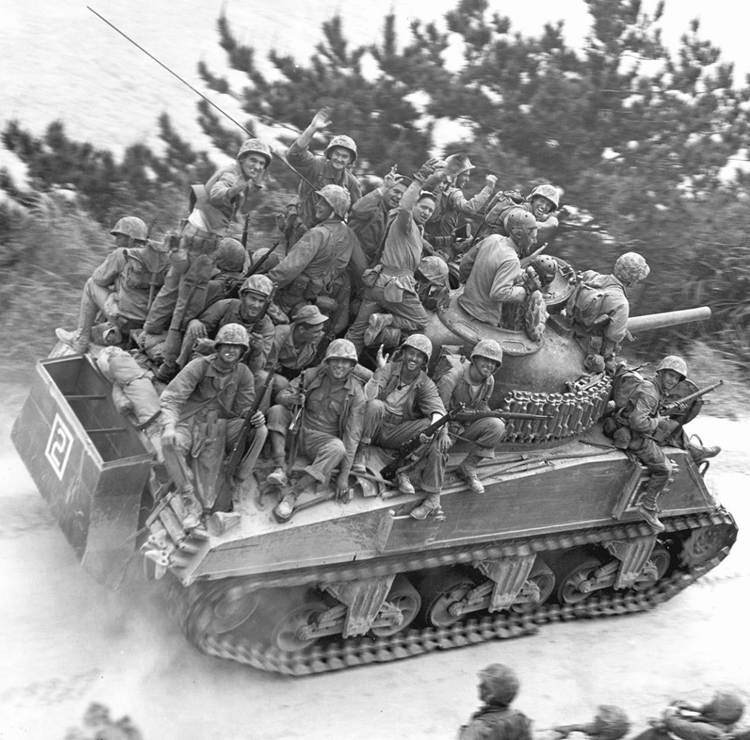 |
| April
1, 1945 Riflemen of the 29th Marine Regiment Ride a M4A3 Sherman 105mm
of Company A, 6th Tank Battalion During the 6th Marine Division Drive
on Chuda, Okinawa |
|
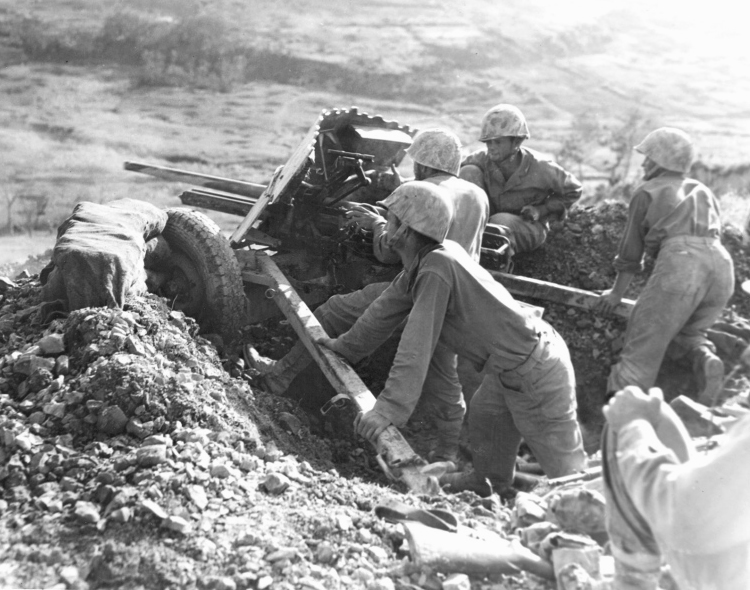 |
| May 9, 1945 US Marines use 37mm Gun to Pound
Imperial Japanese Pill Boxes During the Battle of Okinawa Island |
|
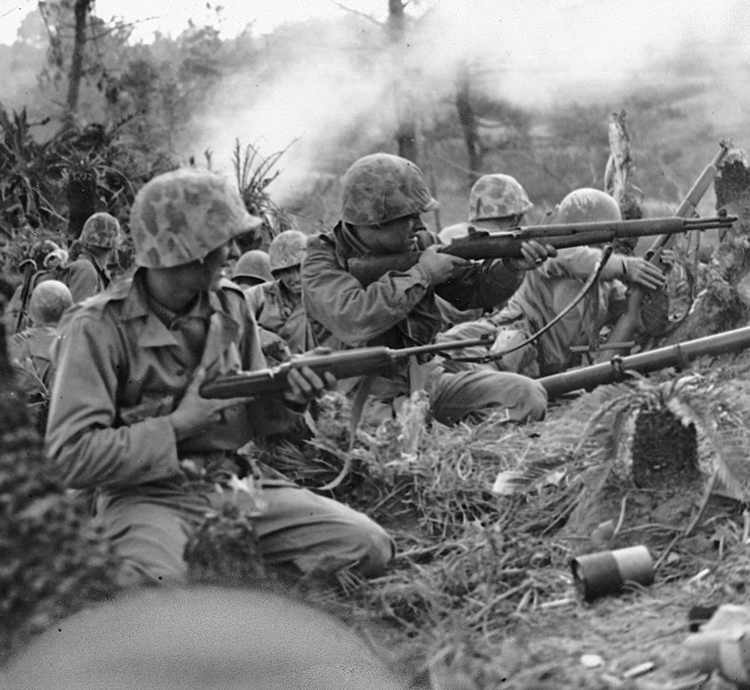 |
| May 1945 US Marines Control Ridge at Naha,
Okinawa |
|
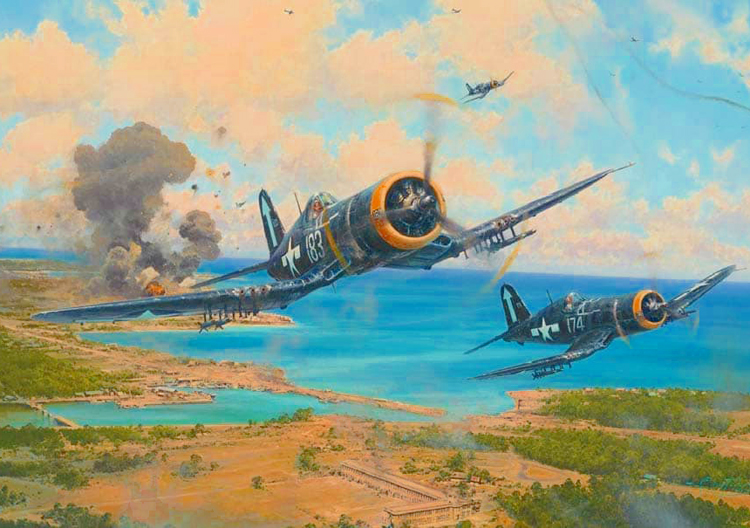 |
| April
9, 1945 Pilots from US Marine Corps Fighter Squadron, VMF-312
Checkerboarders, First to Land Their Vought F4U-1D Corsairs on
Kadena Airfield, Okinawa Soon Followed by VMF-323 Death Rattlers,
VMF-322 Fighting Gamecocks and a Single Night Fighter Squadron,
VMF(N)-543 Night Hawks, Operating Grumman F6F(N) Hellcats to Provide
Interception and Close Air Support for the Liberation of the Island of
Okinawa |
|
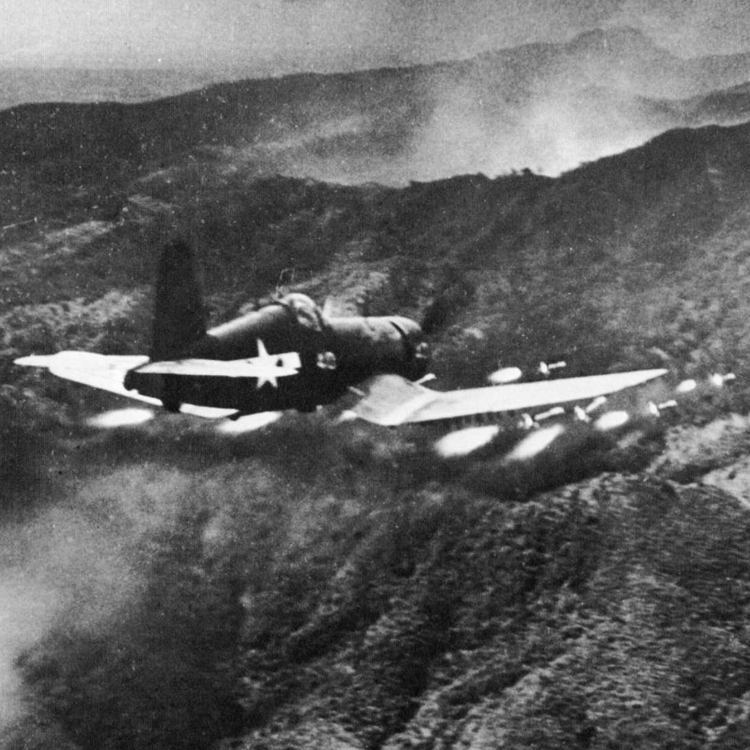 |
| April
3, 1945 United States Marine Corps VMF-323 "Death Rattlers" Fighter
Squadron Vought Corsair Fires Rockets in Close Air Support of Allied
Ground Troops on Okinawa Island |
|
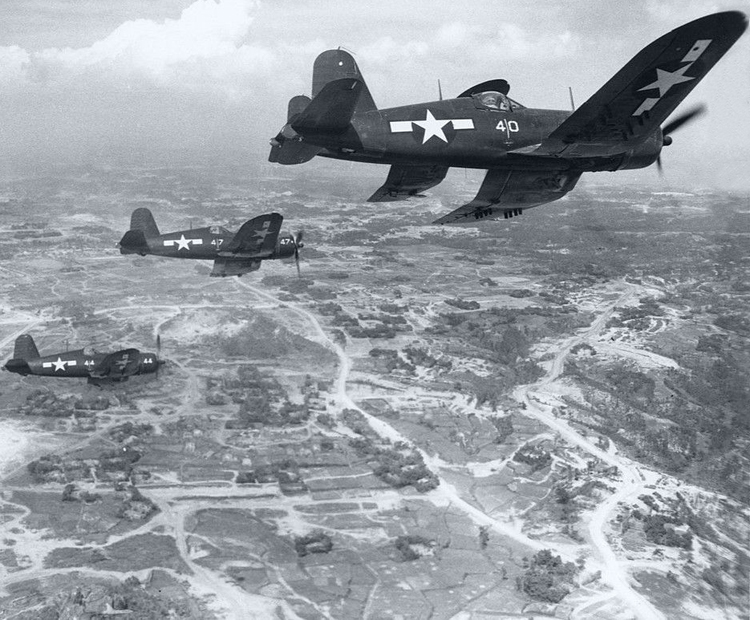 |
| The
most successful WW2 Marine Fighter Squadron of 1945 was VMF-323, the
"Death Rattlers" in their Vought F4U-1D Corsairs. 36 Allied ships were
destroyed in the Battle of Okinawa many by Imperial Japanese Kamikaze
aircraft raids. VMF-323 shot down 124 enemy planes and counted a dozen
aces while operating from Kadena Airfield, Okinawa between April 9 and
July 15, 1945. |
|
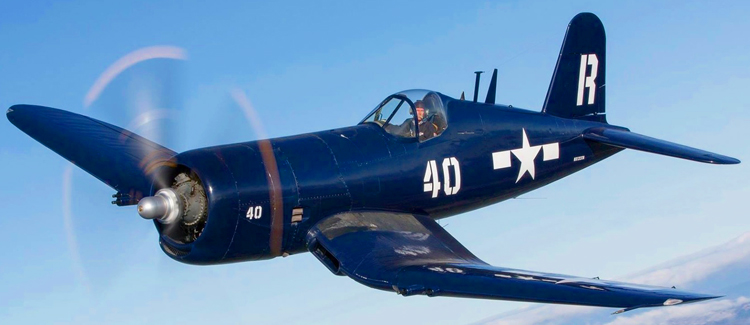 |
|
|
| August 1943 United
States Marine Corps Vought F4U-1 Corsairs of VMF-323 Death Rattlers get
Their Name from a Rattle Snake Encounter While Training in North
Carolina, Now VMFA-323 Based with Other Squadrons of Third
Marine Aircraft Wing, 3D MAW, at Miramar Marine Corps Air Station, San
Diego, CA |
|
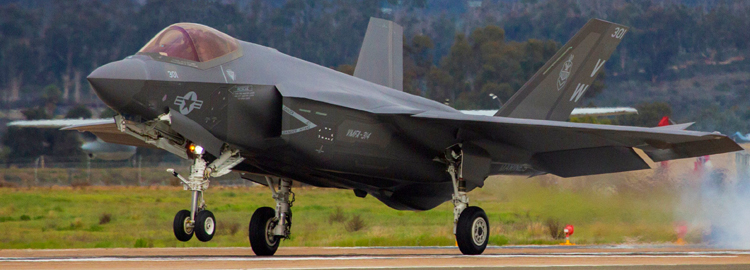 |
| January
21, 2020 Lockheed Martin F-35C Lightning II Stealth Fighter, Aircraft
Carrier Variant (CV), Third Marine Aircraft Wing, 3D MAW, Miramar
Marine Corps Air Station, San Diego, CA |
|
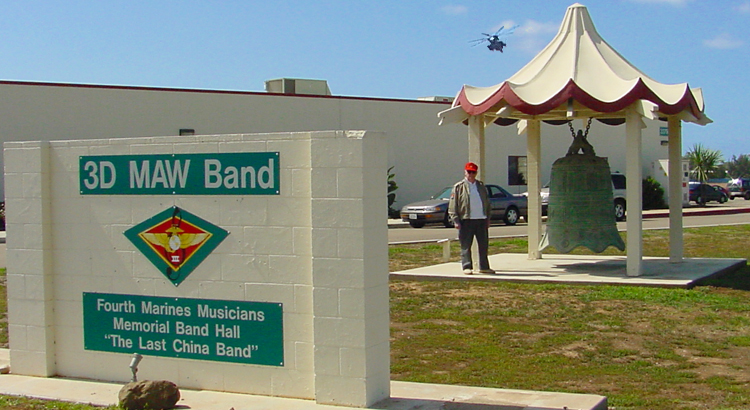 |
China Bell
Master Sergeant
Donald LeRoy Versaw
United States Marine Corps
Retired / WWII POW
Last
China Band
Fourth Marines Musicians
Memorial Band Hall
3D MAW Band
Third Marine Aircraft Wing
Miramar
Marine Corps Air Station
San Diego, CA
|
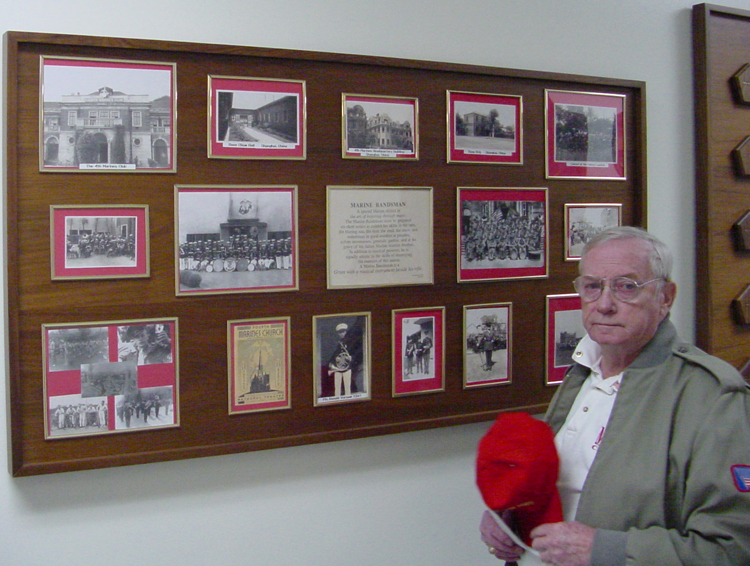 |
| Master
Sergeant Don Versaw, United States Marine Corps, Retired, 4th
Regimental Band, author of the book: "Last China Band", WWII Prisoner
of War and recipient of a well earned Bronze Star Medal with "V" Device
for Acts of Valor in Combat at Corregidor Island, the Philippines,
December 7, 1941 - May 6, 1942. |
|
|
|
|
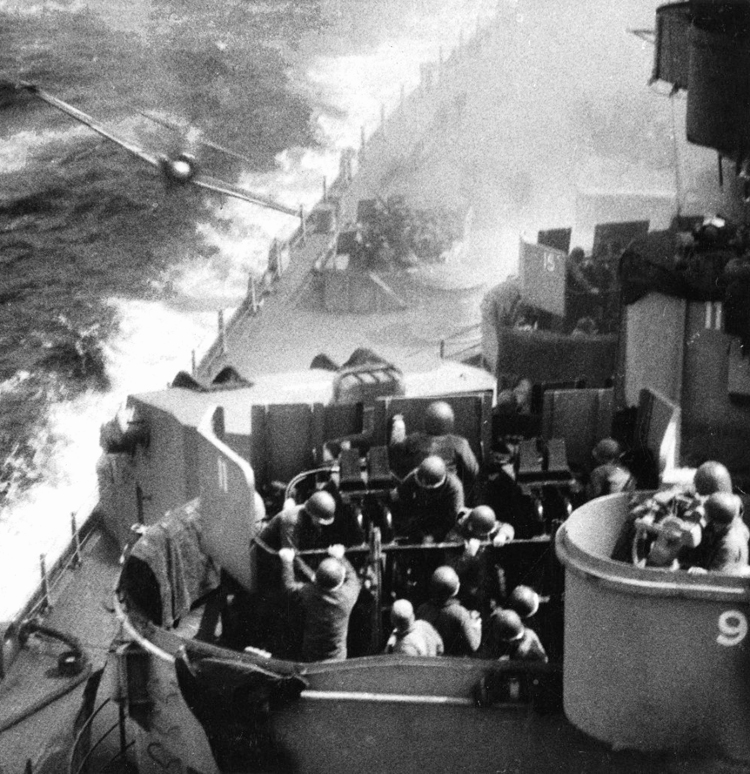 |
| April 11, 1945 Battleship USS Missouri BB-63
off Okinawa Japanese A6M Zero Fighter Kamikaze Causes Minor Damage |
|
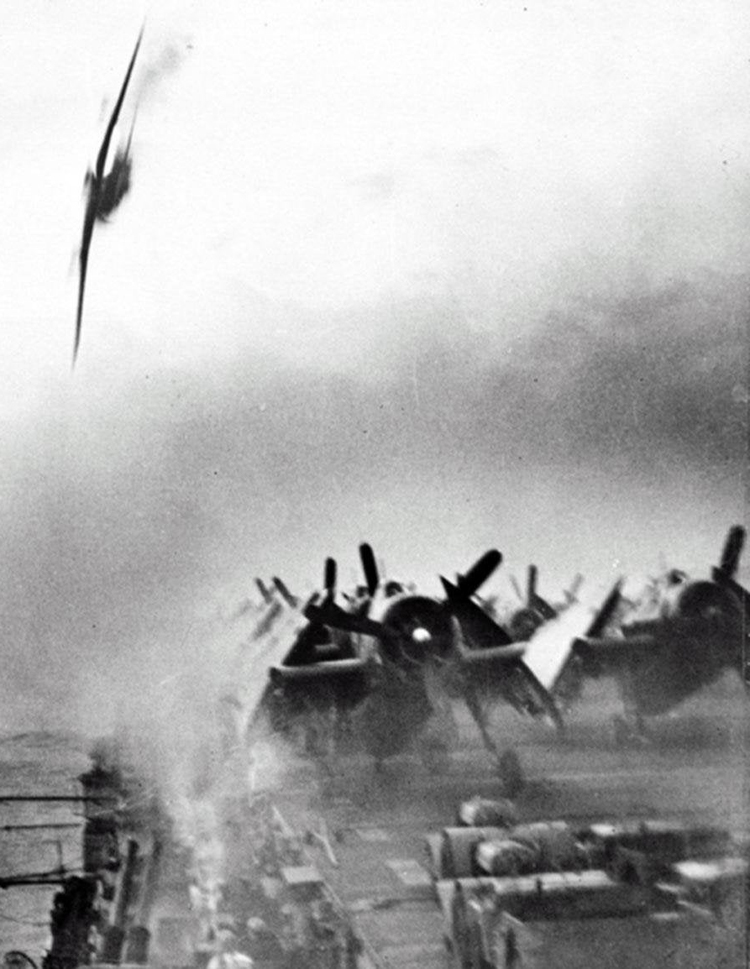 |
| May
4, 1945 Escort Aircraft Carrier USS Sangamon CVE-26 Operating off
Okinawa Coast Imperial Japanese Army Air Force Hien Ki-61 Tony Fighter
Kamikaze Attack |
|
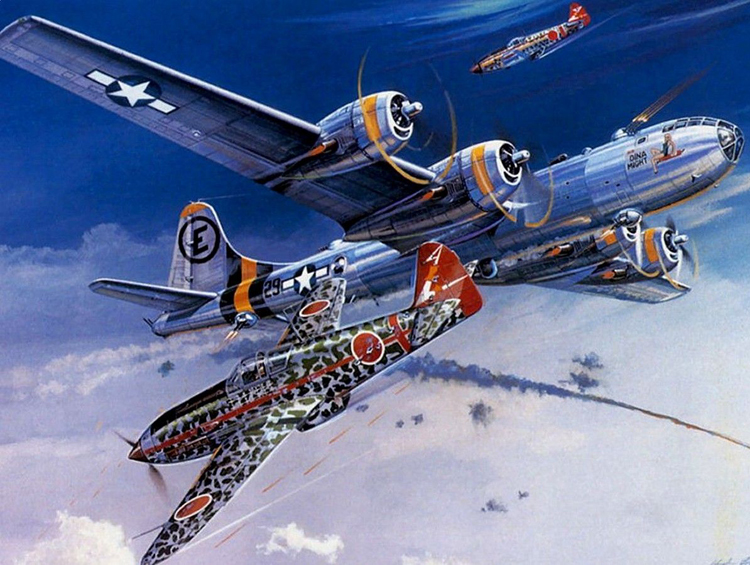 |
| Imperial Japanese Army Air Force Hien Ki-61
Tony Fighters Attempt to Intercept US Boeing B-29 Superfortress Bomber |
|
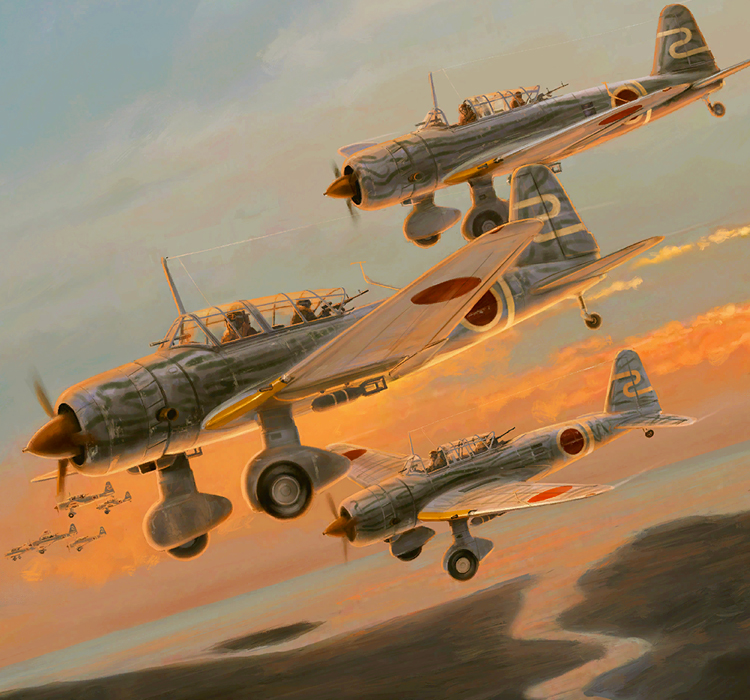 |
| July 26, 1945 British Heavy Cruiser HMS Sussex
Sustains Minor Damage in Dutch East Indies (Indonesia) Japanese Ki-51
Sonia Light Bomber/Dive Bomber Kamikaze Strike to Armored Hull |
|
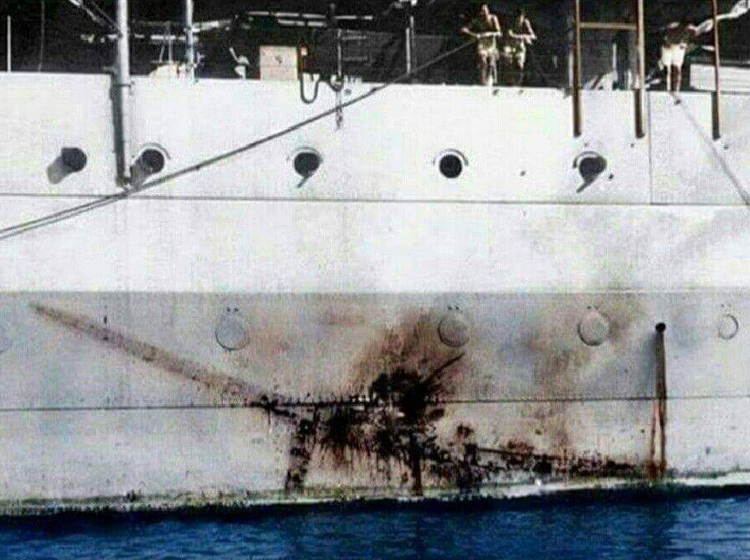 |
|
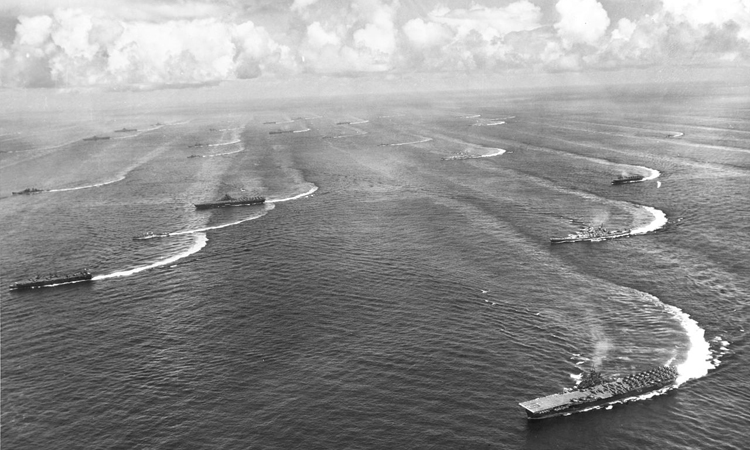 |
| August 17, 1945 Task Force 38 of US Navy Third
Fleet off Coast of Japan Two Days After Empire Agrees to Surrender |
|
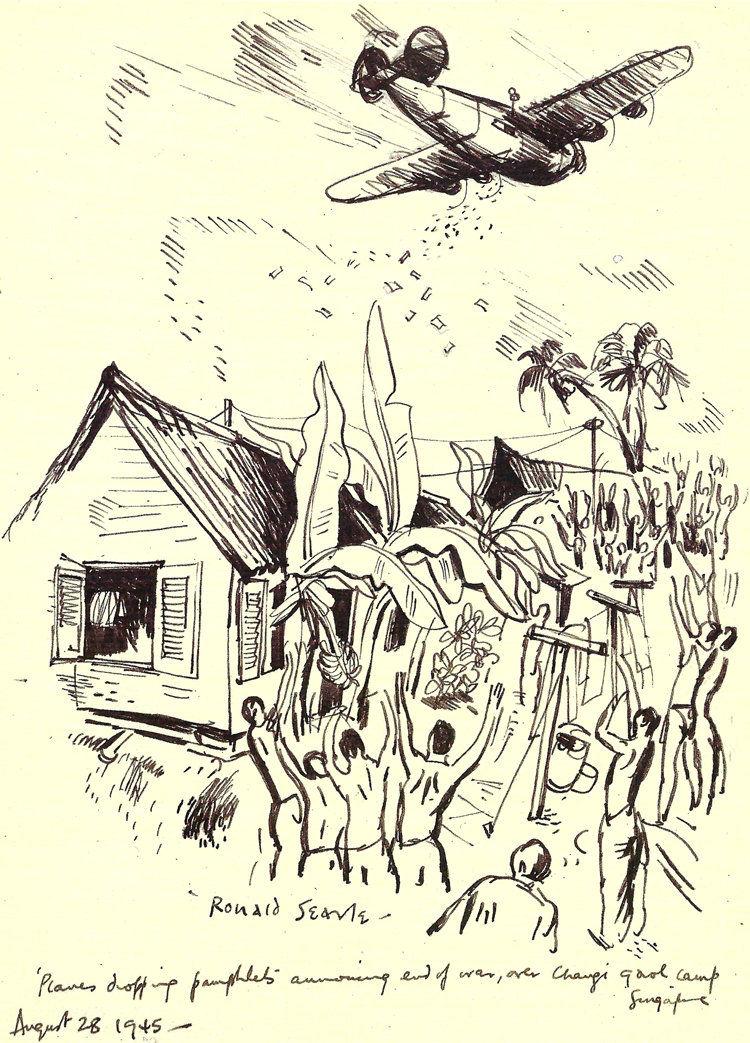 |
| August
28, 1945 Planes Dropping Pamphlets Announcing End of War Over Changi
Gaol Prisoner of War Camp Singapore to Allies from Britain, Australia
and Canada in this Contemporaneous Drawing by Fellow POW Ronald Searle,
British Army |
|
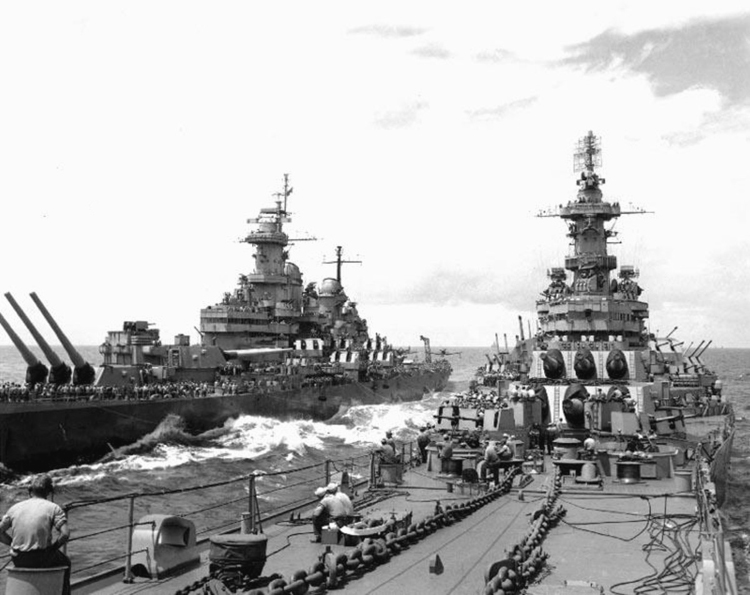 |
| August
20, 1945 Battleship USS Missouri BB-63 at left transferring personnel
to Battleship USS Iowa BB-61 while operating off Japan. |
|
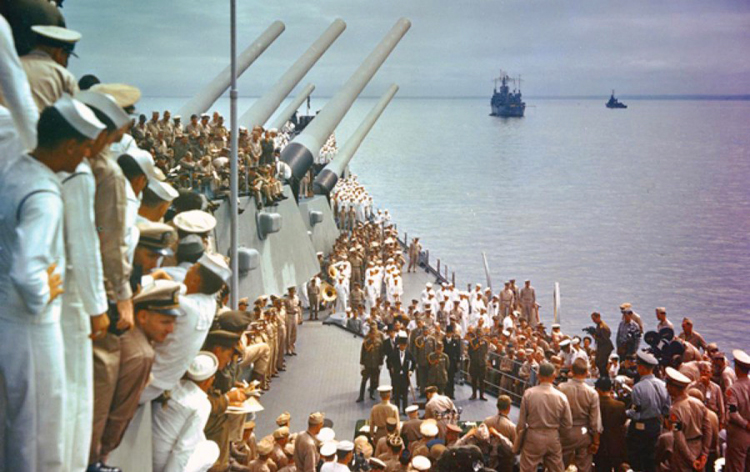 |
| September
2, 1945 Empire of Japan Officials Sign World War II Surrender to US
Army General Douglas MacArthur Aboard Battleship USS Missouri BB-63 in
Tokyo Bay as Japanese War Crime Suspects are Investigated and Prisoner
of War Camps in Japan are Liberated After Three Years of Combat,
Captivity, Deprivation and Forced Labor for Many Allied Personnel |
|
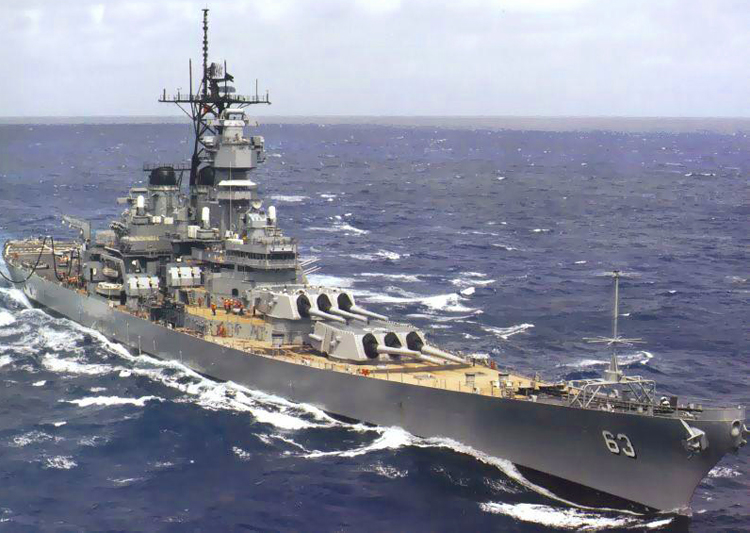 |
| Battleship
USS Missouri BB-63 Photo Above and Battleship USS Iowa BB-61 Photo
Below Both Same Design Class and Served at Tokyo Bay Imperial Japan
Surrender |
|
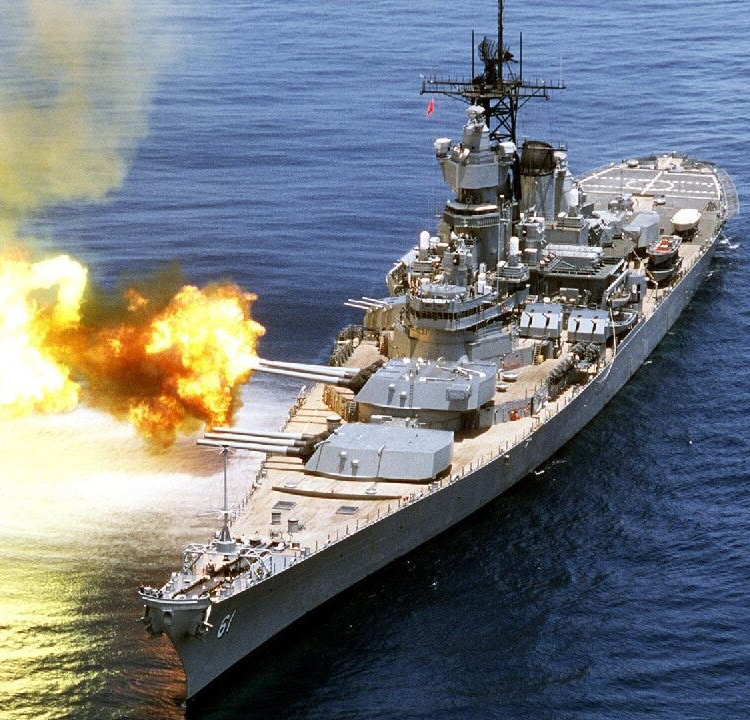 |
United States of America and
Allied military personnel stationed in the Pacific Theater of World War
Two before the December 7, 1941 Empire of Japan attack on Pearl Harbor,
Hawaii and Manila Bay, the Philippine Islands, turn the tide of
momentum from aggressive Japanese expansion to concern for the survival
of the Emperor, himself before the cavalry from the United States
mainland actually show up.
Admiral Yamamoto's warning about
awakening a sleeping giant did not take in to account the determined
resistance in combat of Allied soldiers, sailors and marines already at
Wake Island, Corregidor, Bataan, Coral Sea and Midway stalling out
Japanese military consolidation of East Asia.
No planned yet
postponed major assault on Australia ever materialized and Japan was no
longer able to conduct simultaneous offensives in both the north and
south Pacific Ocean.
Before USS Essex CV-9 class flattops and
USS Iowa BB-61 class battlewagons weigh in, keels are laid on new LST
and submarine fleets and F4U Corsair and F6F Hellcat Fighter pilots and
B-29 Bomber crews see action, P-40 Warhawk and F4F Wildcat Fighters,
B-17 and B-25 Bombers, SBD Dauntless Dive Bombers, USS Lexington CV-2,
USS Yorktown CV-5, USS Enterprise CV-6 and USS Hornet CV-8 aircraft
carriers fight the first ever aircraft carrier battle May 4-8, 1942 in
the Coral Sea, denying an objective to the Imperial Japanese Navy also
for the first time in WWII, the occupation of Port Moresby, an
Australian territory at that time, and destroy four aircraft
carriers of the IJN Fleet at the Battle of Midway Island, June 4-7,
1942.
Allied forces largely in place prior to the initiation of
hostilities held fascism in check from the Battle of Britain to the
Solomon Islands, turning offense to defense for Hitler's Thousand Year
Third Reich, Il Duce Mussolini's Blackshirts and Tojo claiming to
represent the Chrysanthemum Throne of the Mikado Hirohito before the
final grim task of rolling up the Axis on an industrial scale could
begin.
Master Sergeant Don Versaw, United States Marine Corps,
Retired, 4th Regimental Band, author of the book: "Last China Band",
WWII Prisoner of War and recipient of a well earned Bronze Star Medal
with "V" Device for Acts of Valor in Combat at Corregidor Island, the
Philippines, December 7, 1941 - May 6, 1942, during repatriation from
Japan by his US GI liberators via the devastation of the port of
Nagasaki and huge Allied build up on the Island of Okinawa, quipped
that he had never seen ships and planes so large and rifles so small.
|
|
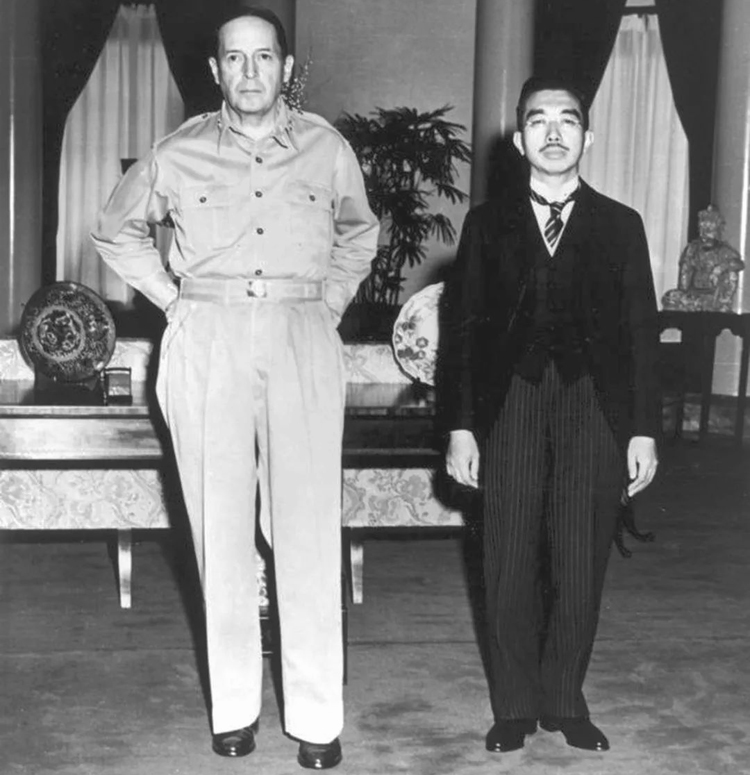 | | September
27, 1945 United States of America Embassy in Tokyo, Japan, U.S. Army
General Douglas MacArthur and Japanese Emperor Michinomiya Hirohito
First Ever Meeting | 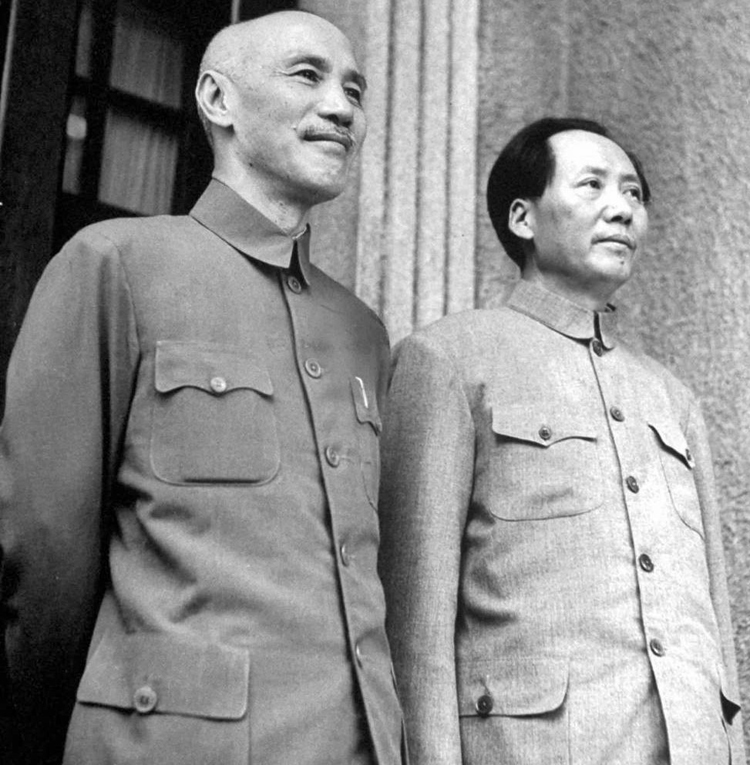
1945 Chiang Kai-shek, Kuomintang (KMT) Chinese Nationalist Party and Mao Zedong, Communist Party of China
United_States_Marines_In
North_China_1945-1949.pdf
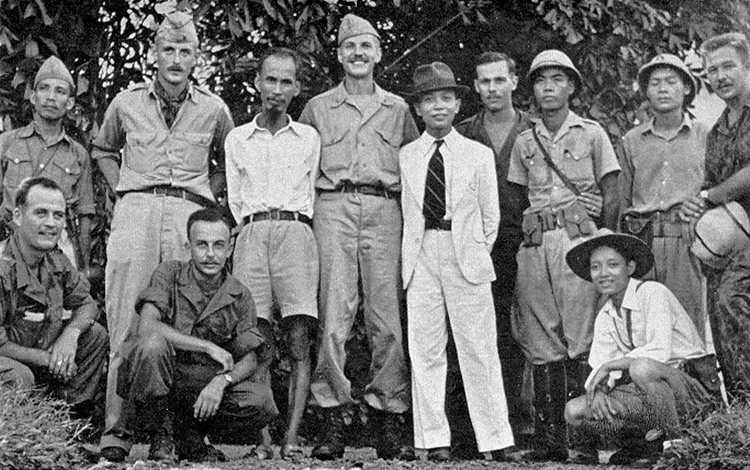
1945
Hồ Chí Minh, Standing Third from Left, with United States Office of
Strategic Services (OSS) Advisors in French Indochina (Vietnam, Laos,
Cambodia) |
| |
80 Years Since Attack on
Pearl
Harbor and the Philippines
December 7, 2021 |
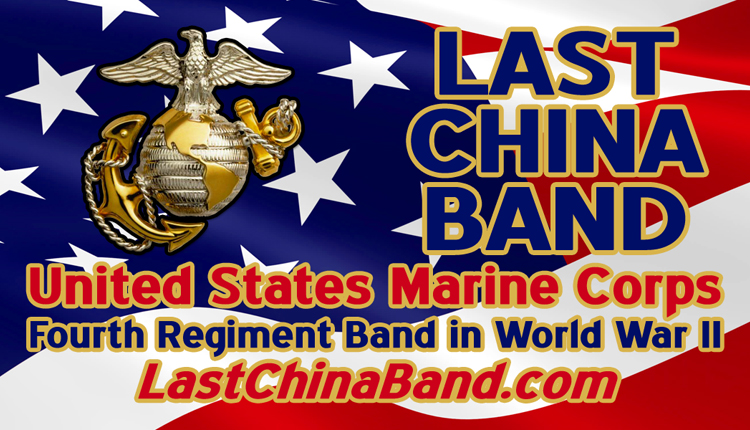 |
| Last China Band Digital Card |
Copy and paste to a text or email.
Below is a printable version
with eighth inch trim edges: |
Last_China_Band
Business_Card.pdf |
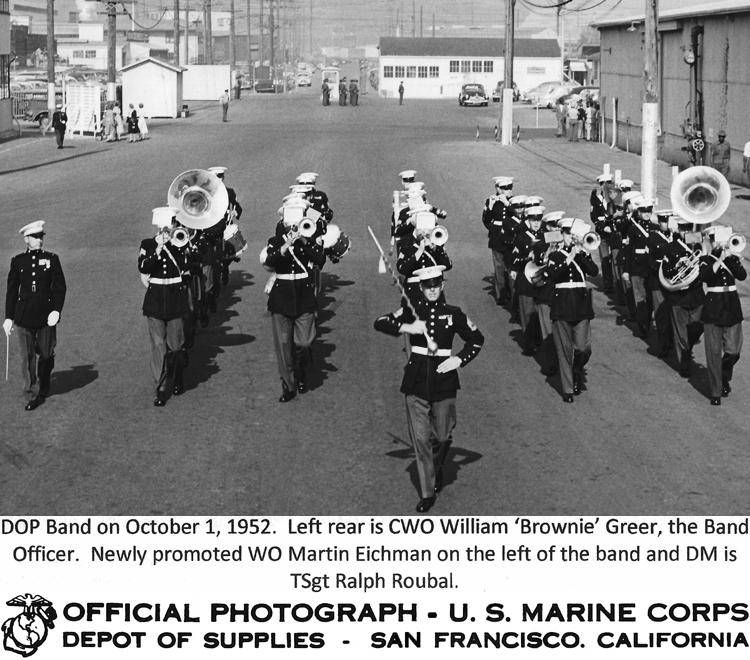 |
Last
China Band Members and Former World War II Prisoners of War Martin
Eichman, Jack P. Rauhof, Kenneth Marshall and Other Late 1940's and
1950's USMC Bands Original Photo Prints from Third Marine Aircraft Wing
Band, 3rd MAW, Miramar Marine Corps Air Station, San Diego, CA and
Marine Corps Musicians Association Historian
Band Photos After WWII
Miramar 3D MAW Band
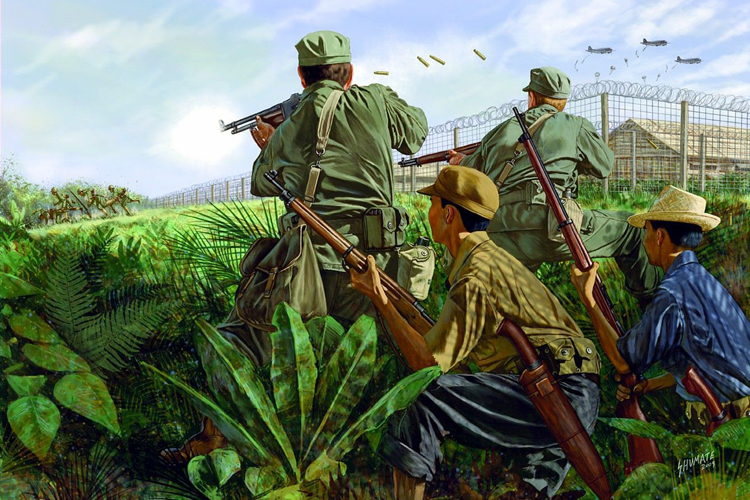
Angels of Bataan
US Army and Navy
WWII POW Nurses
Rescue February 1945
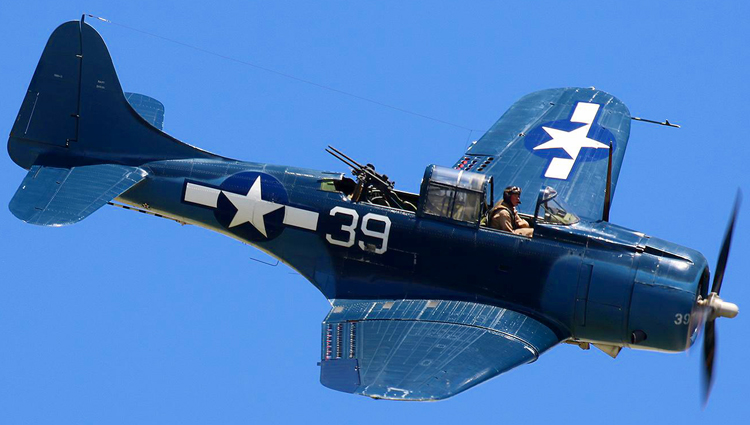
February
3, 1945 US Marine Corps Douglas SBD Dauntless Close Air Support for
Santo Tomas, Philippines US POW Rescue
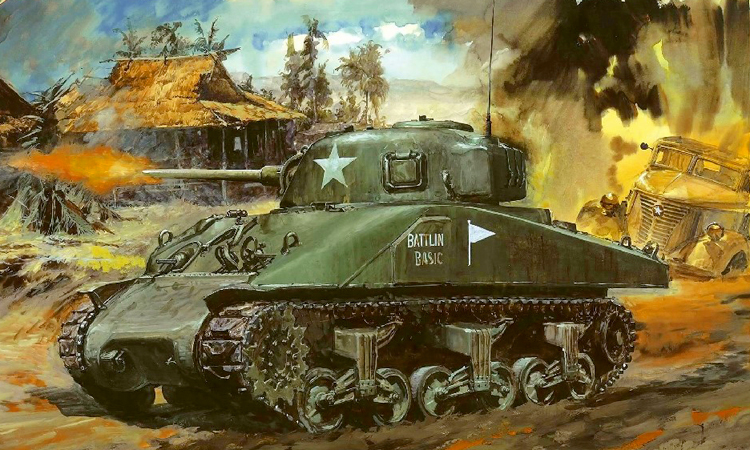
|
|
|
|
|
|
©2000-2023 LastChinaBand.com. All rights reserved.
|
